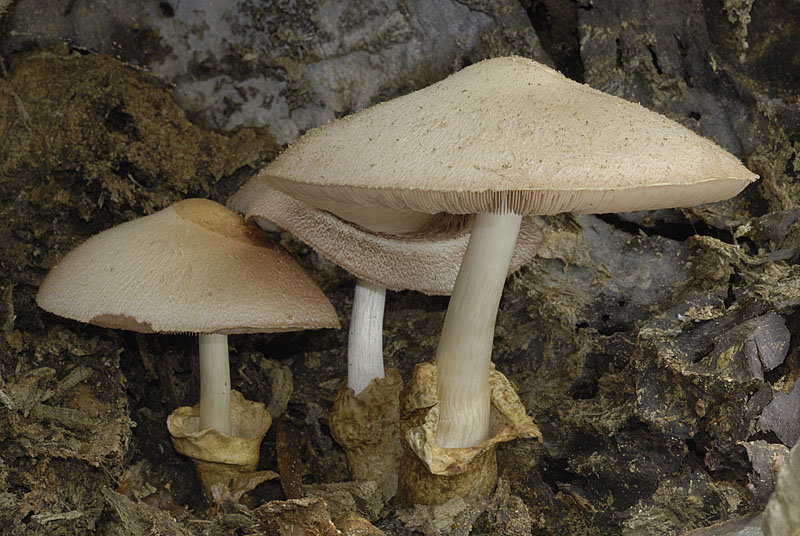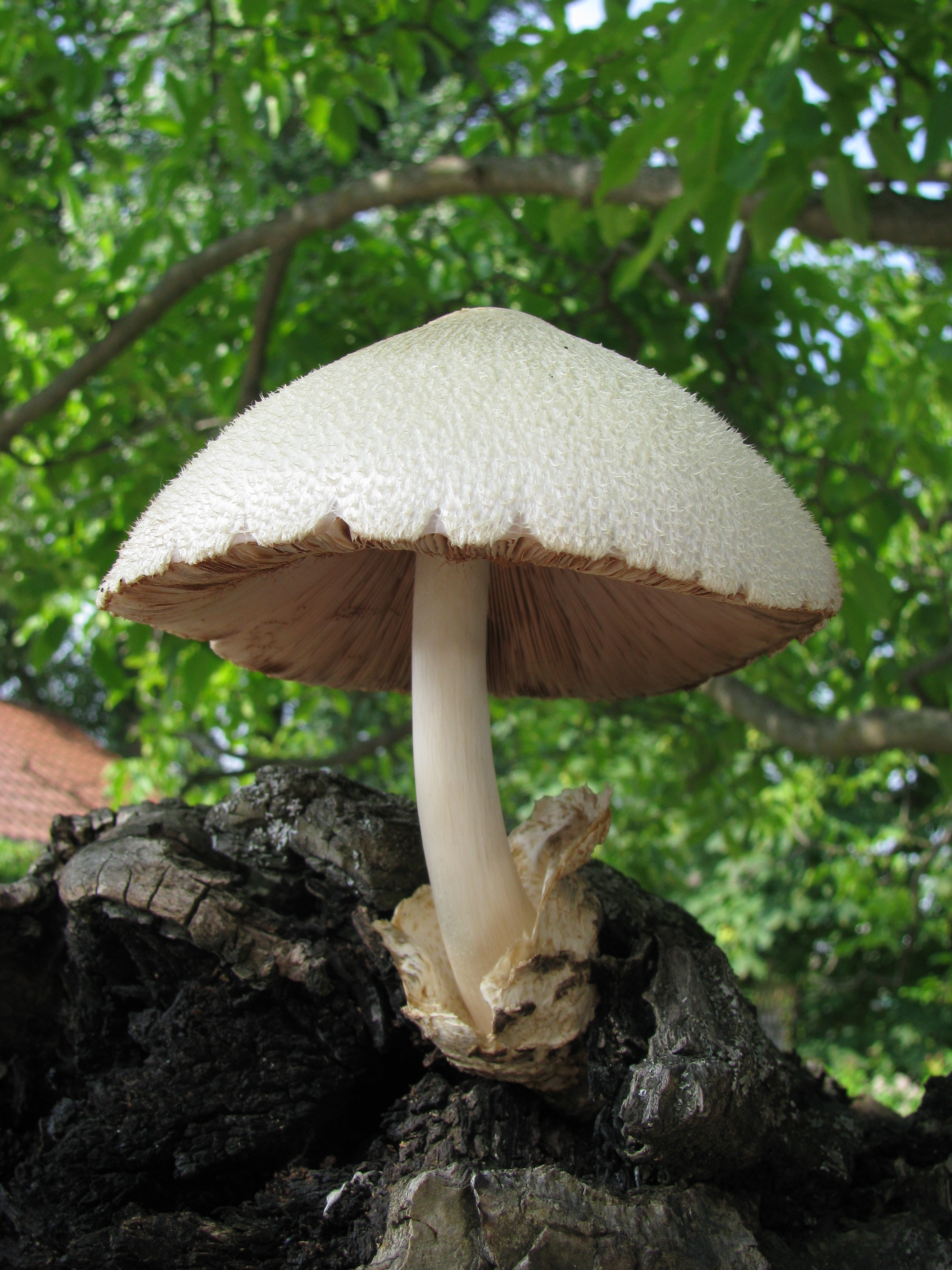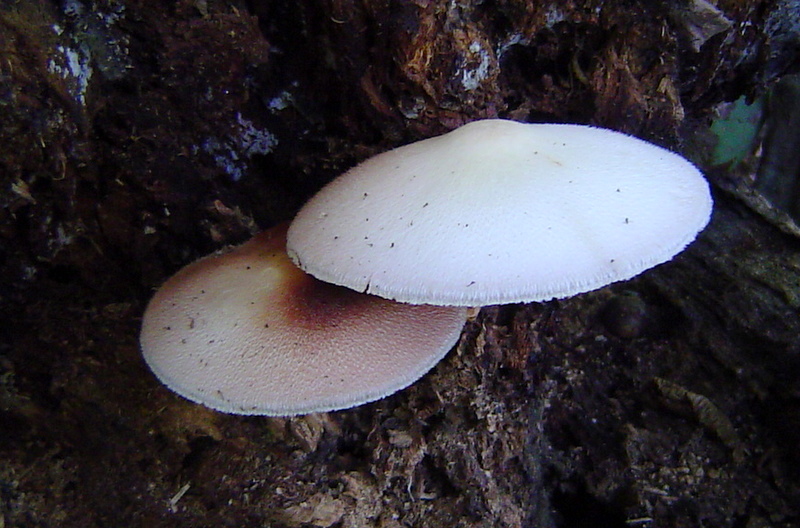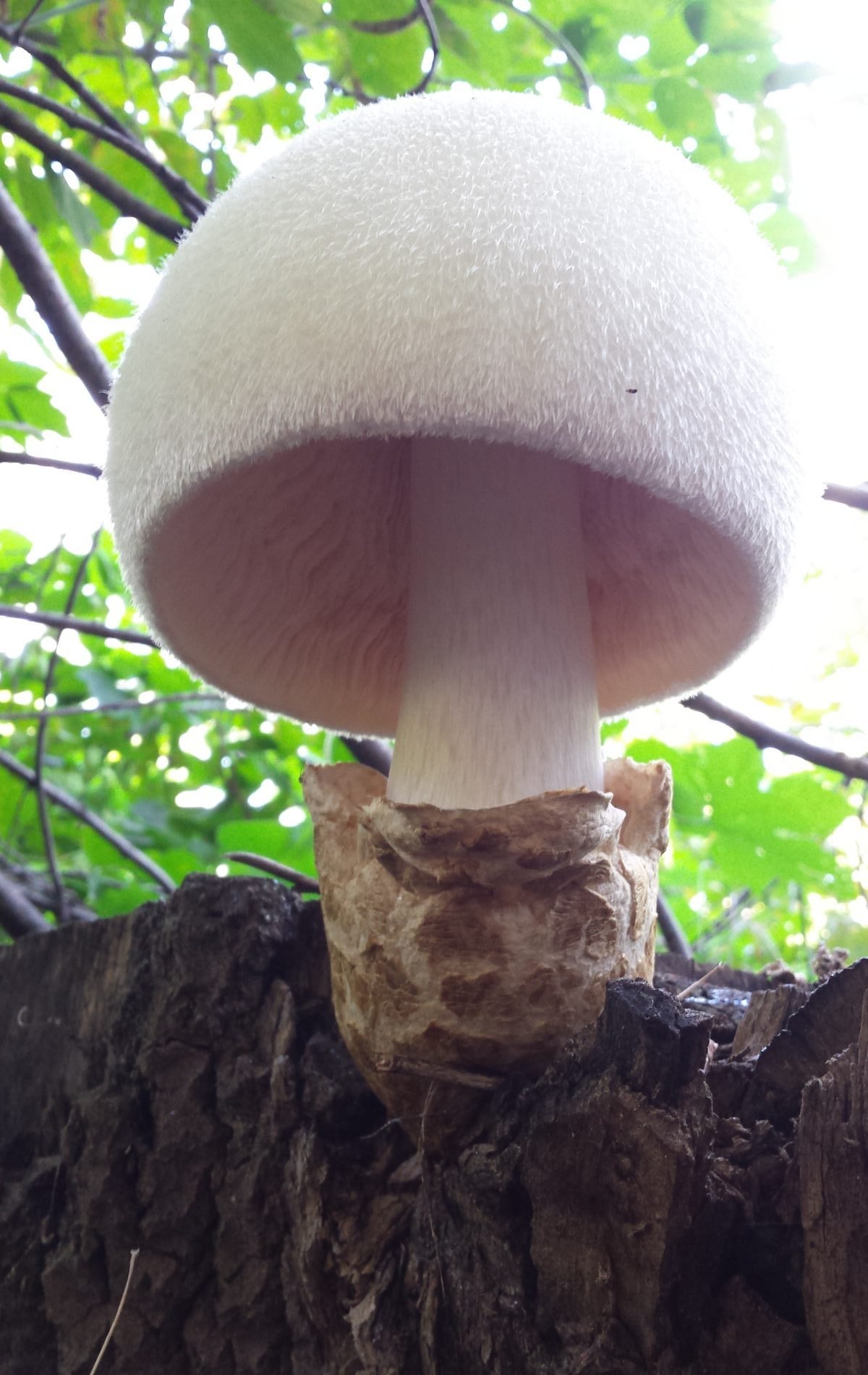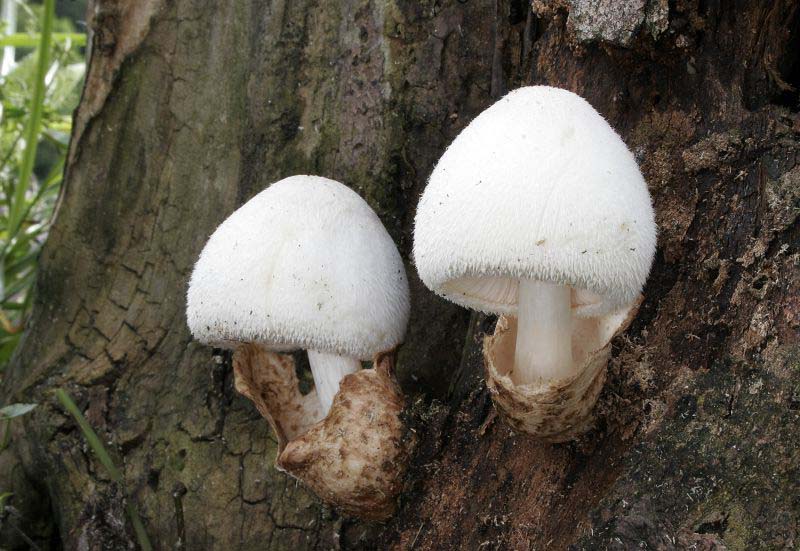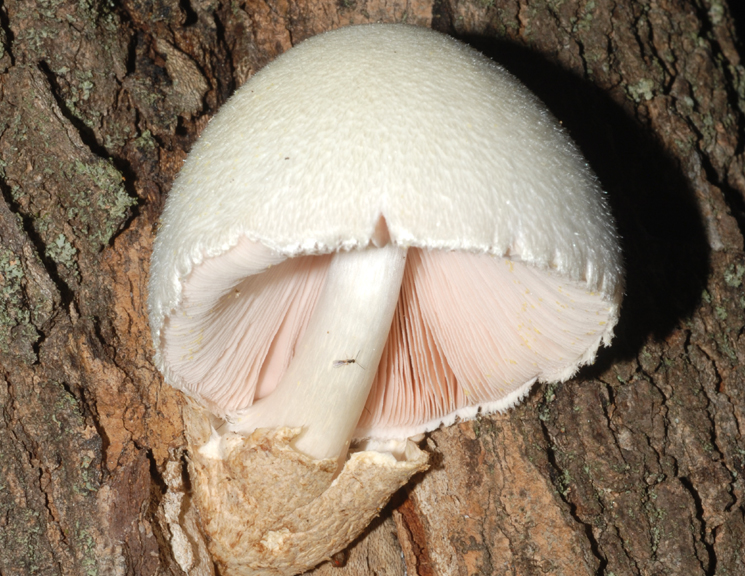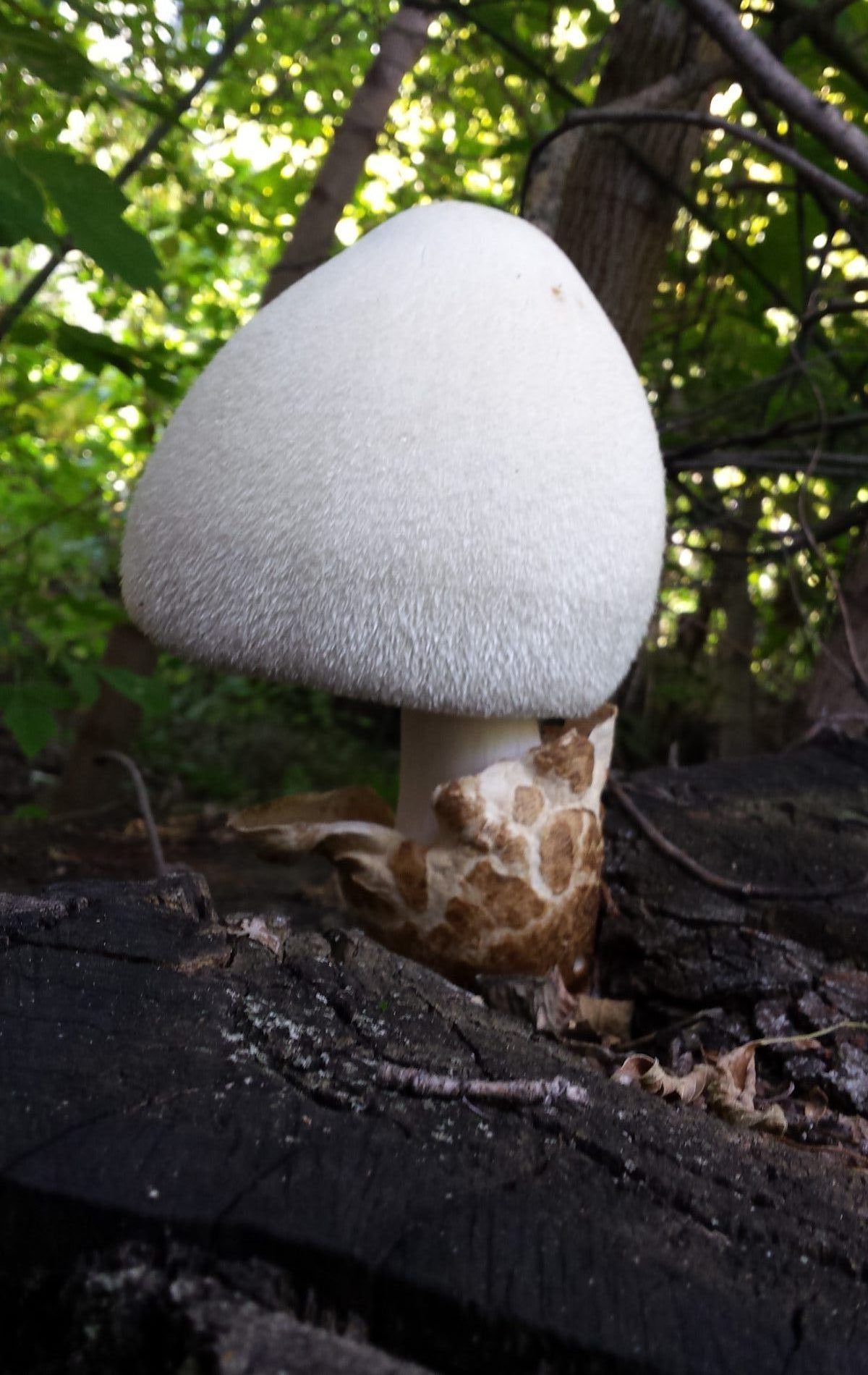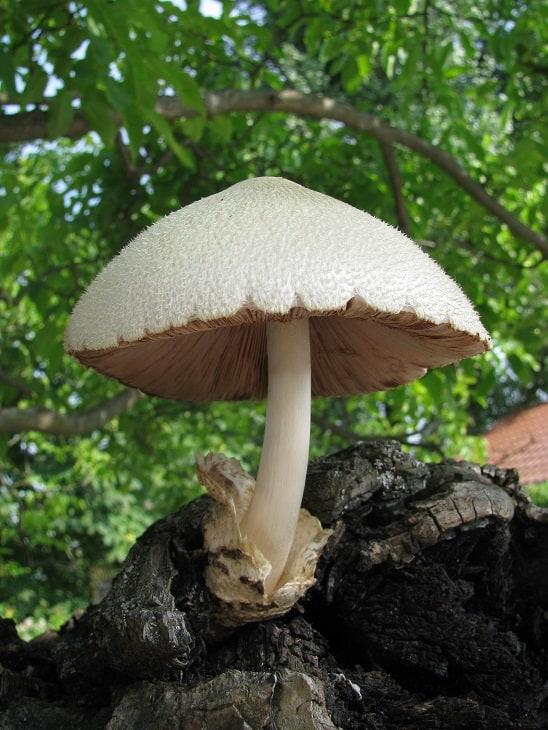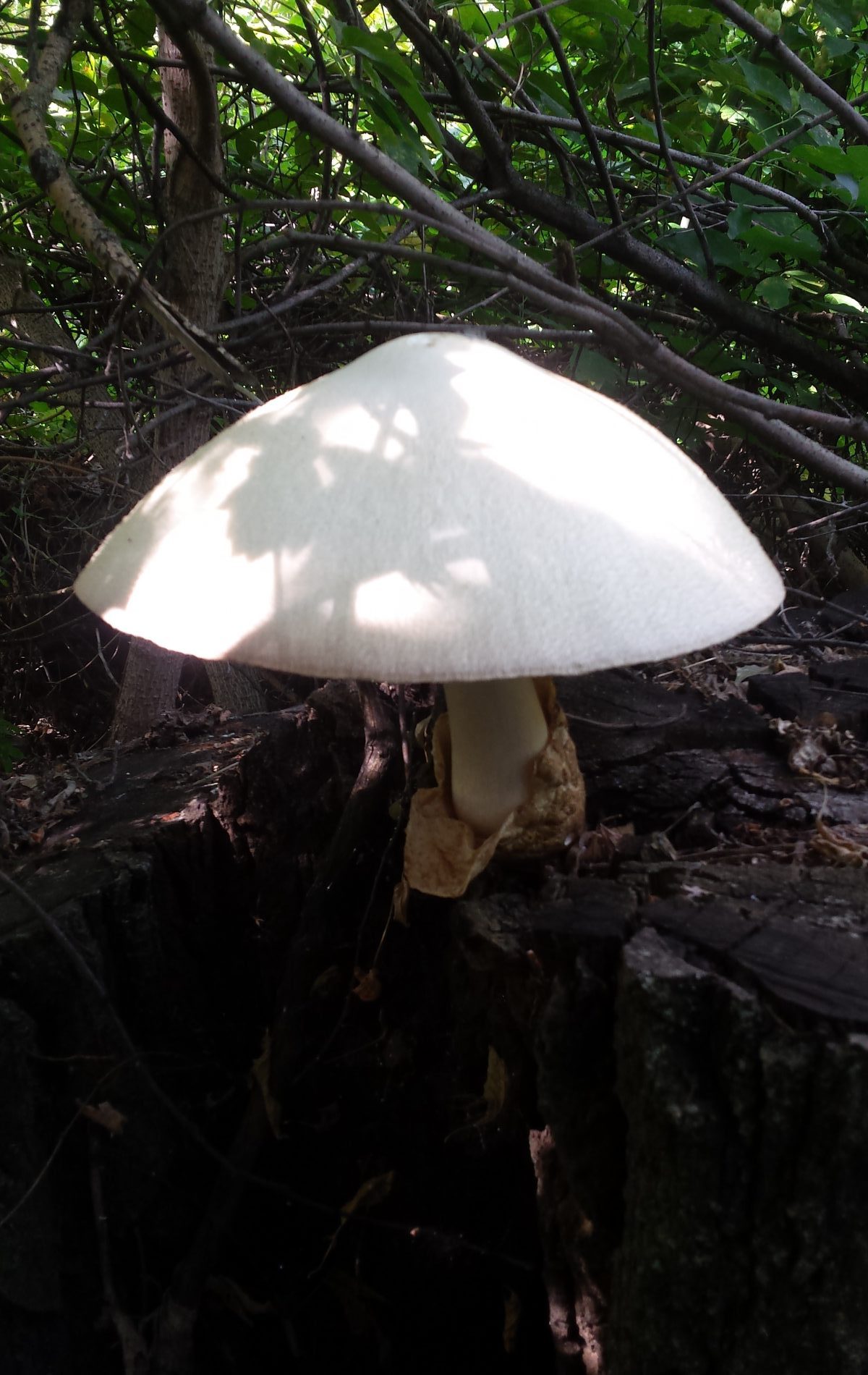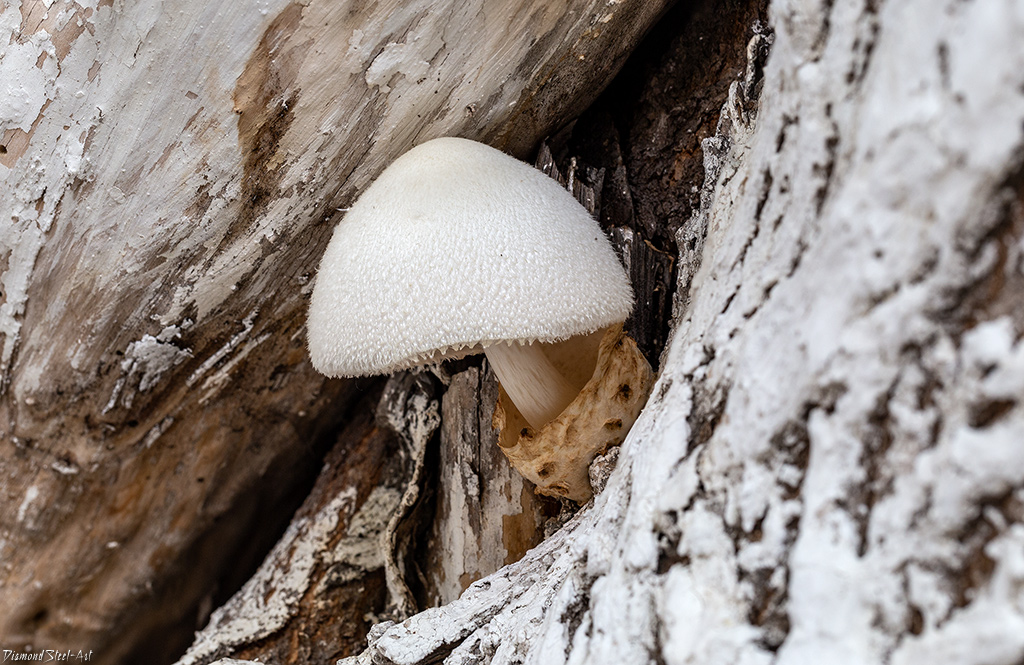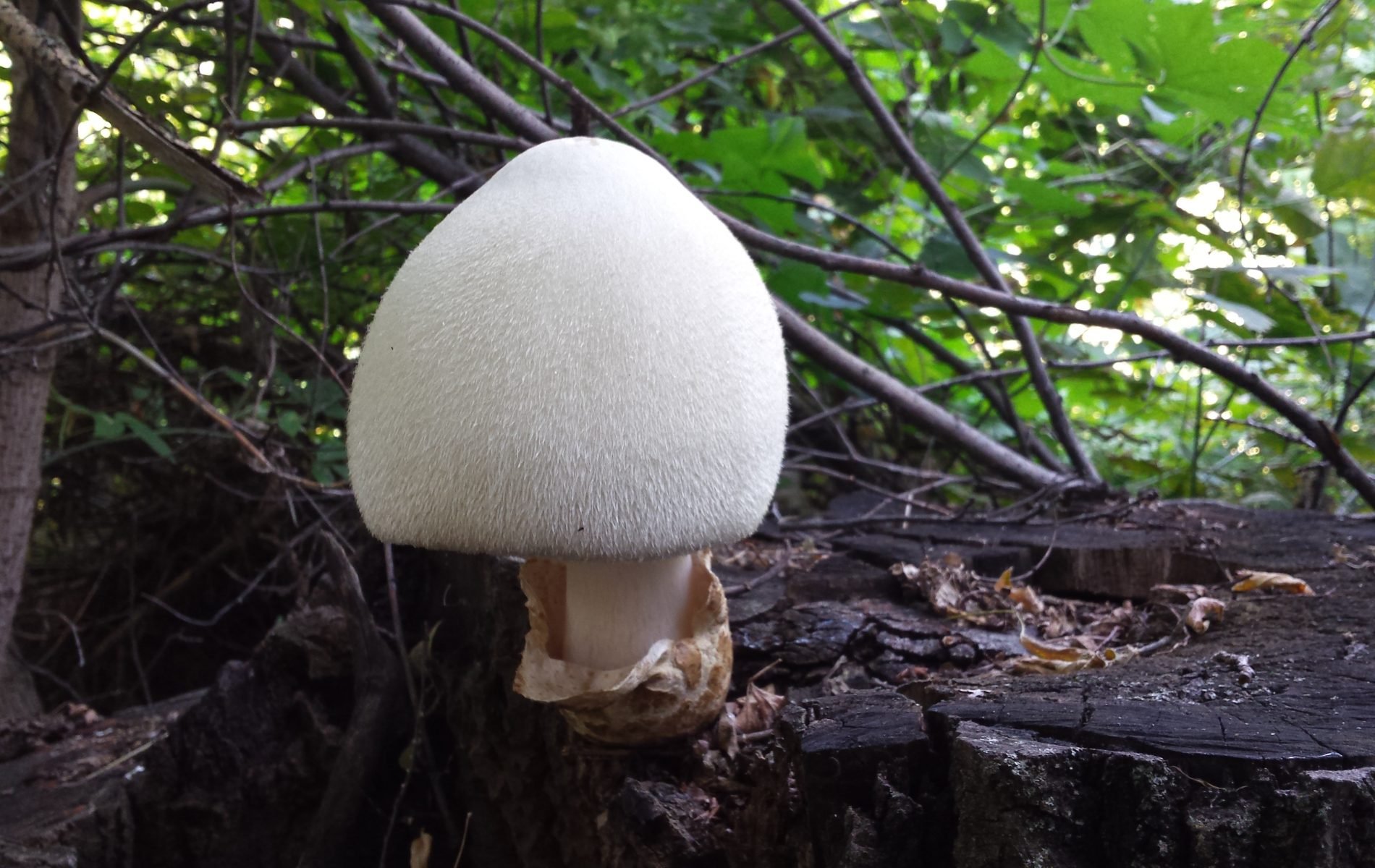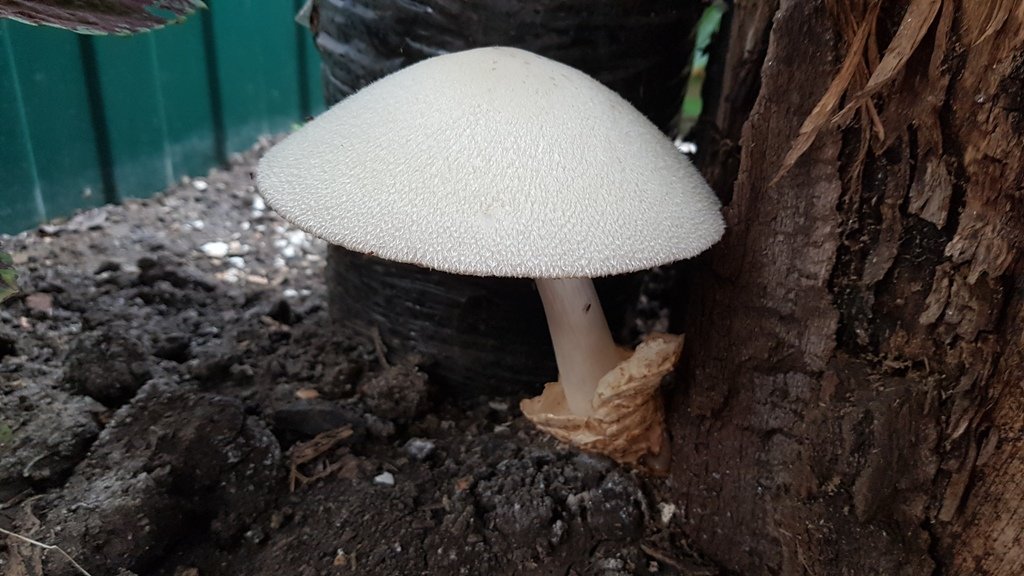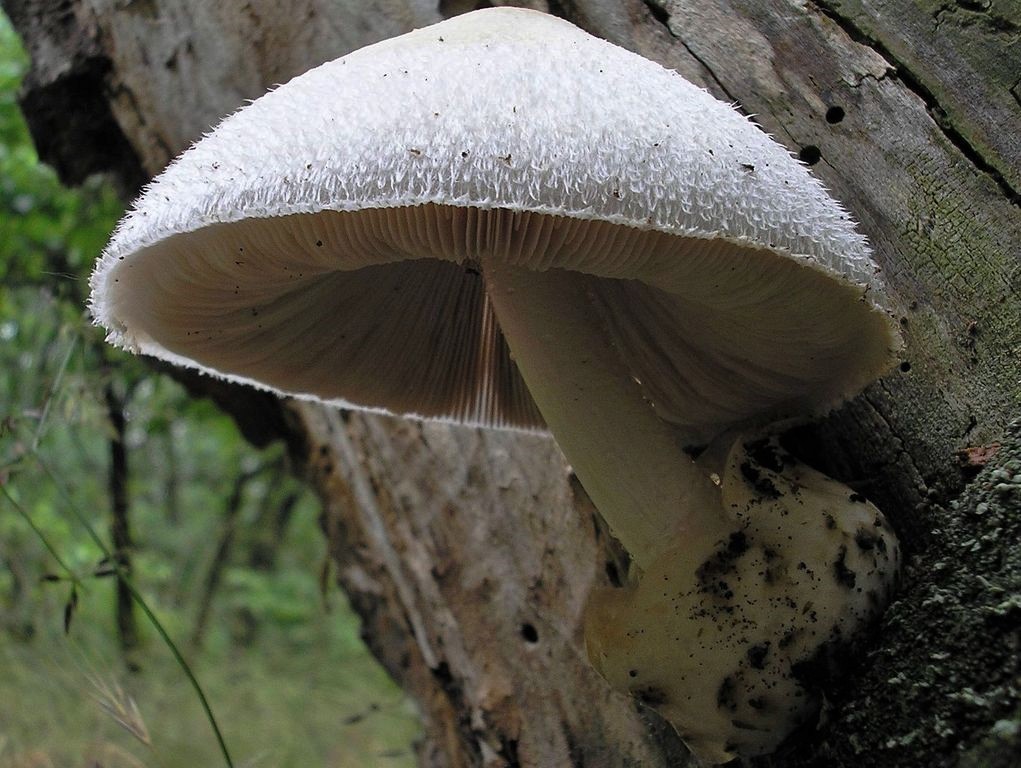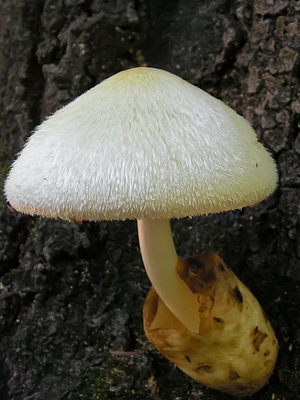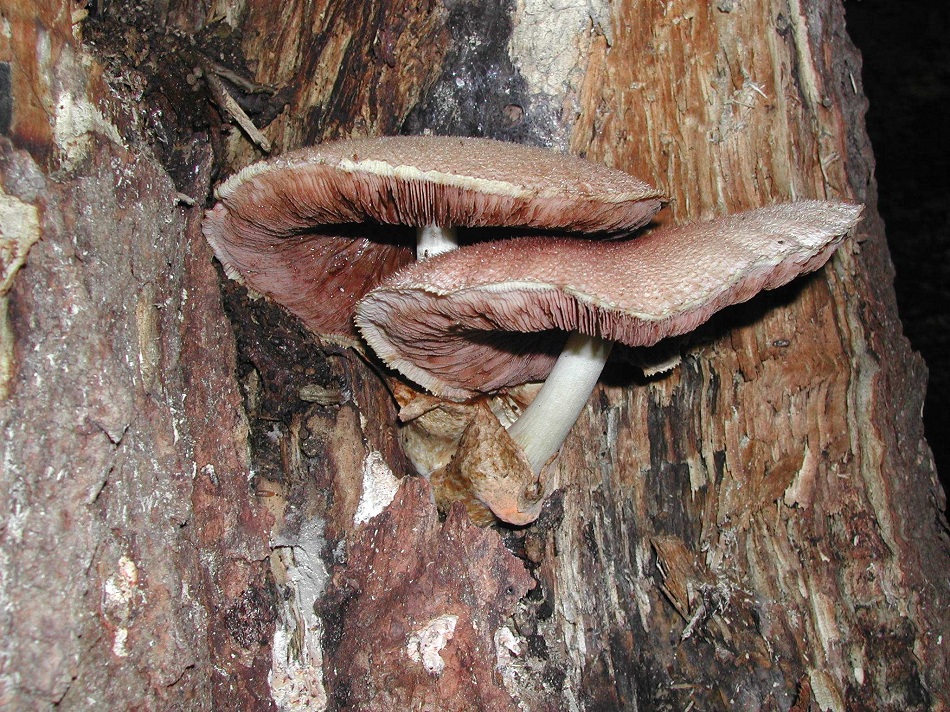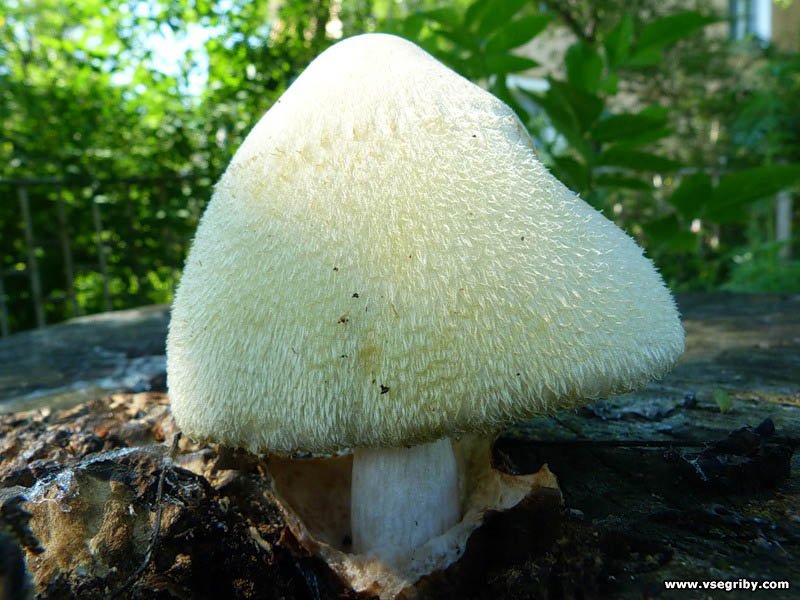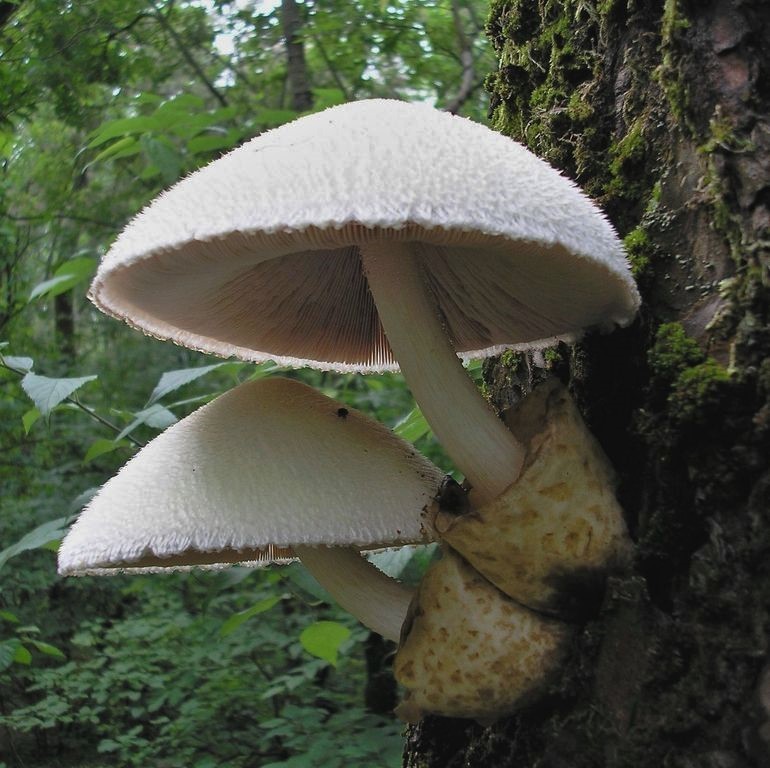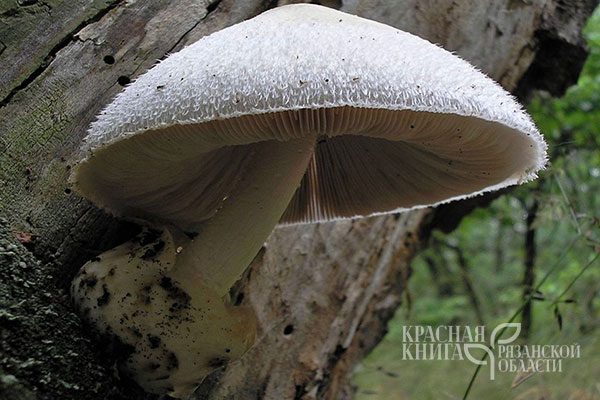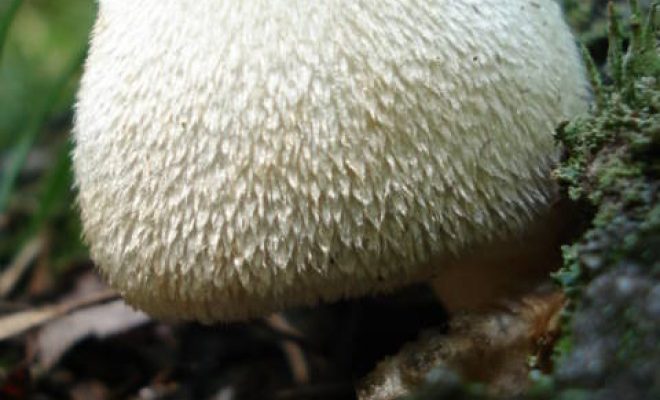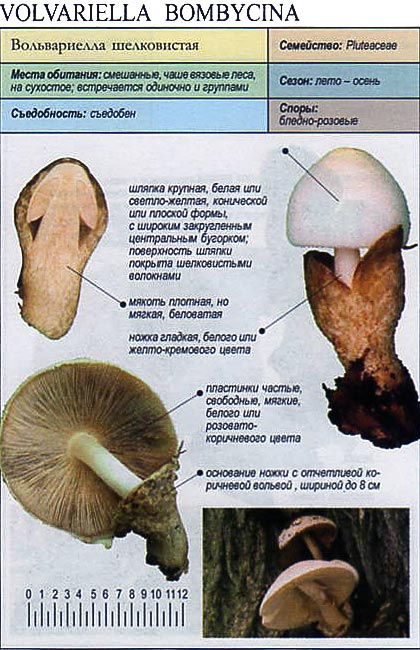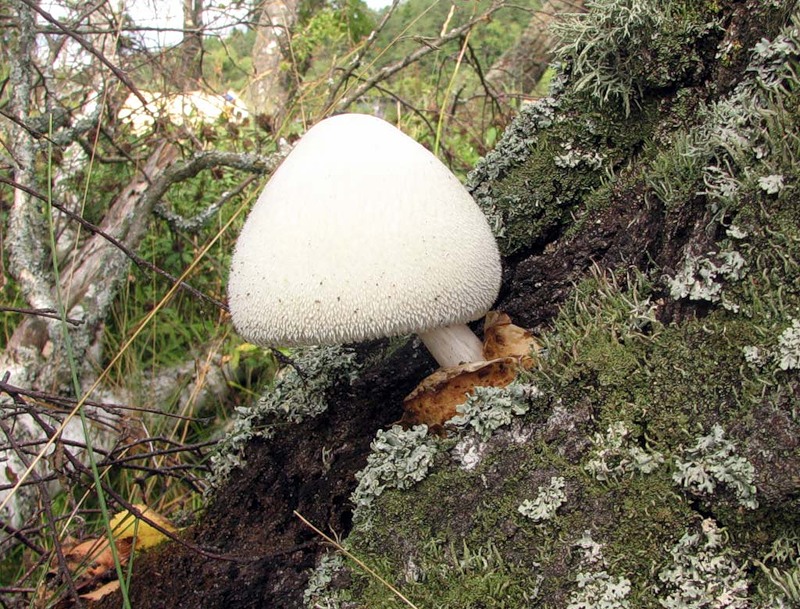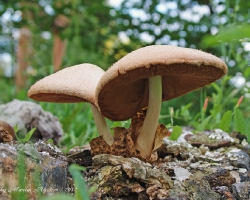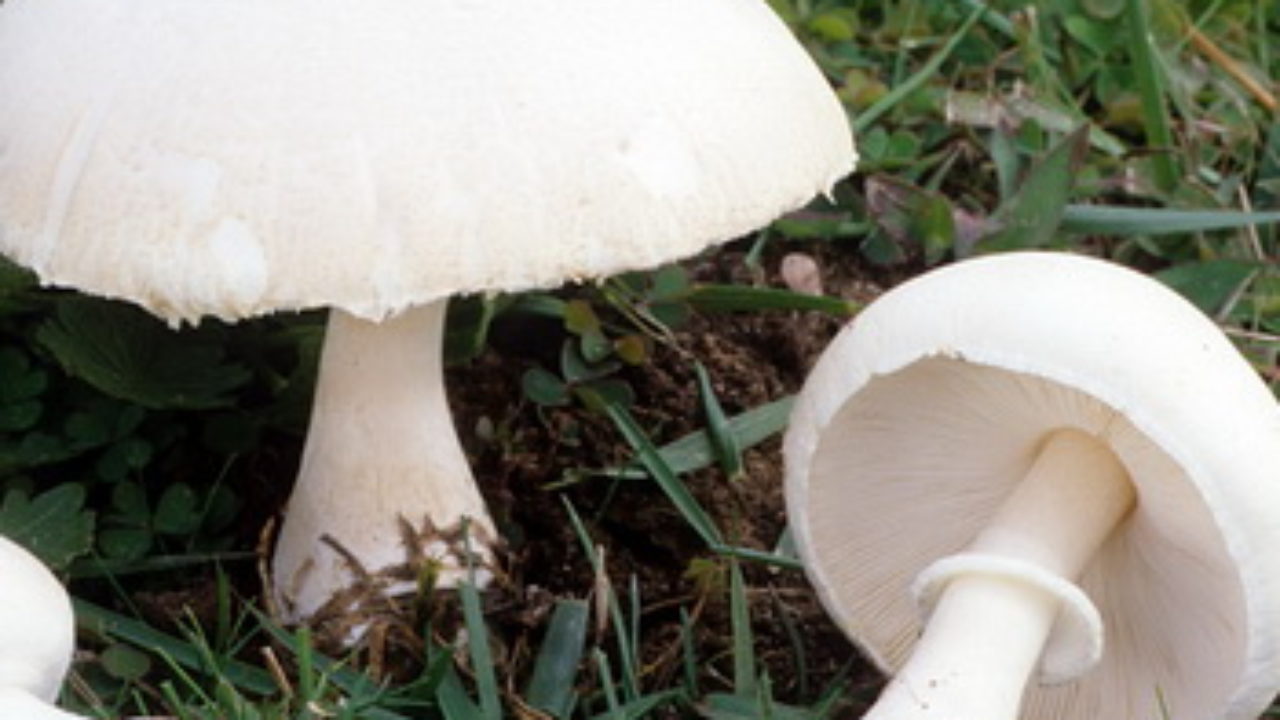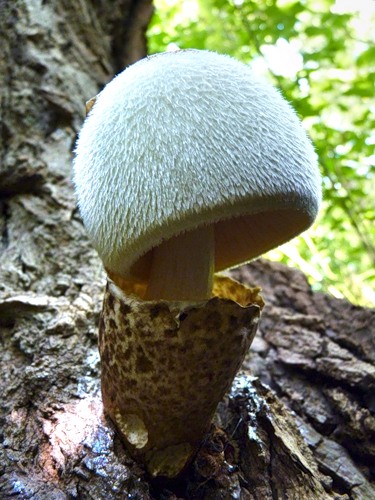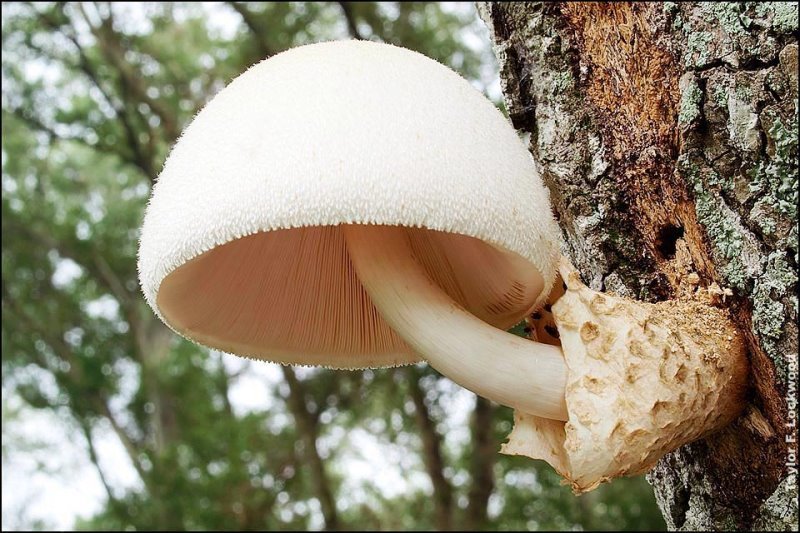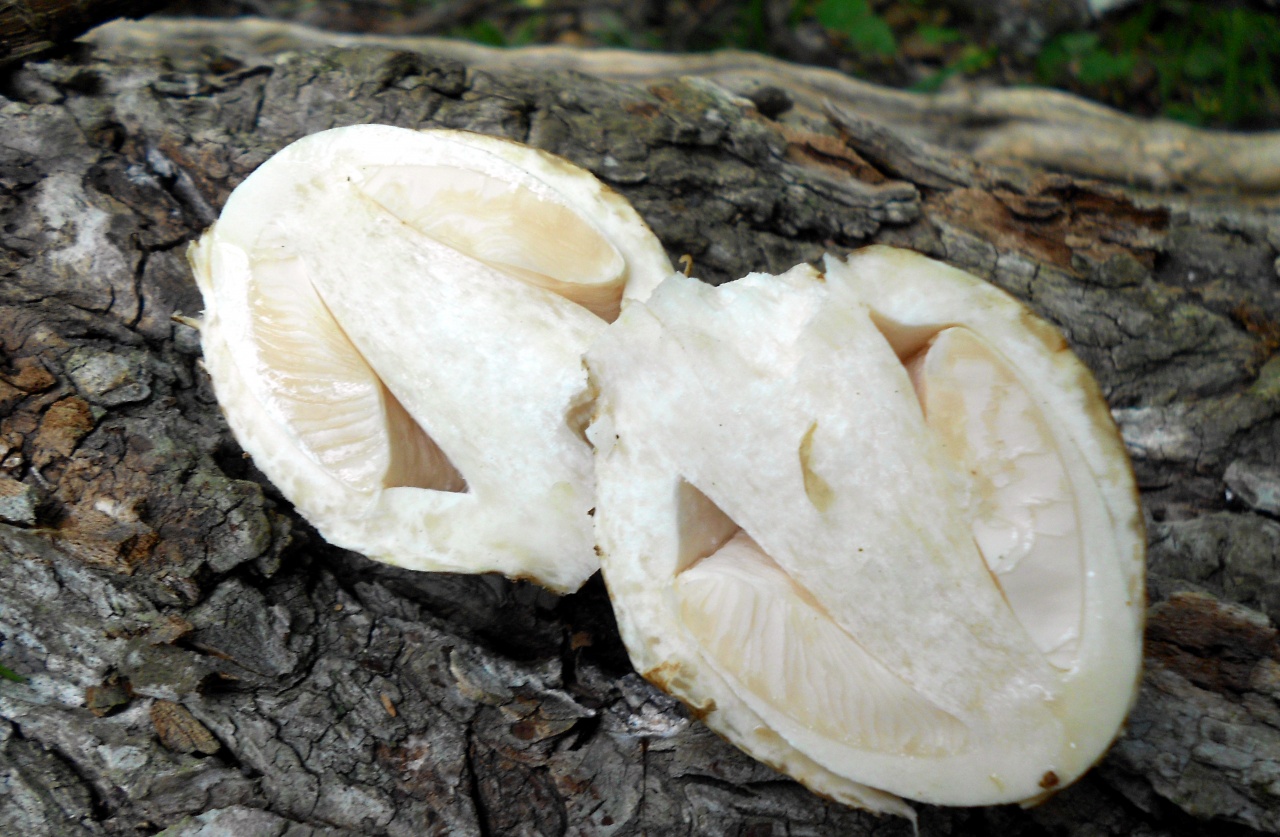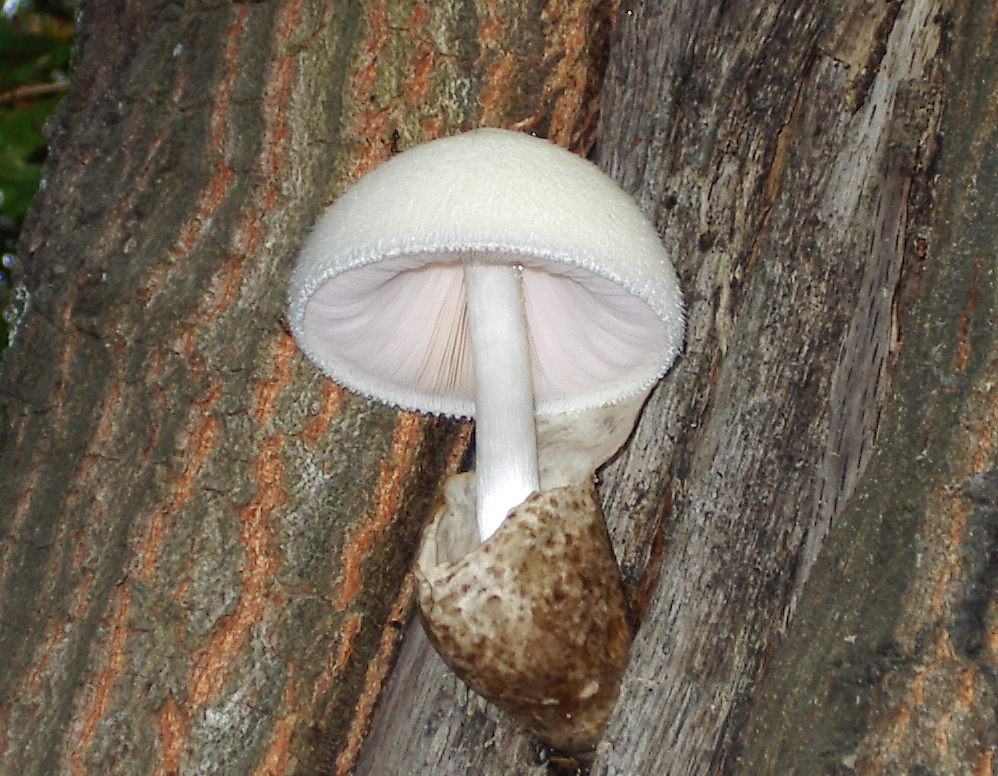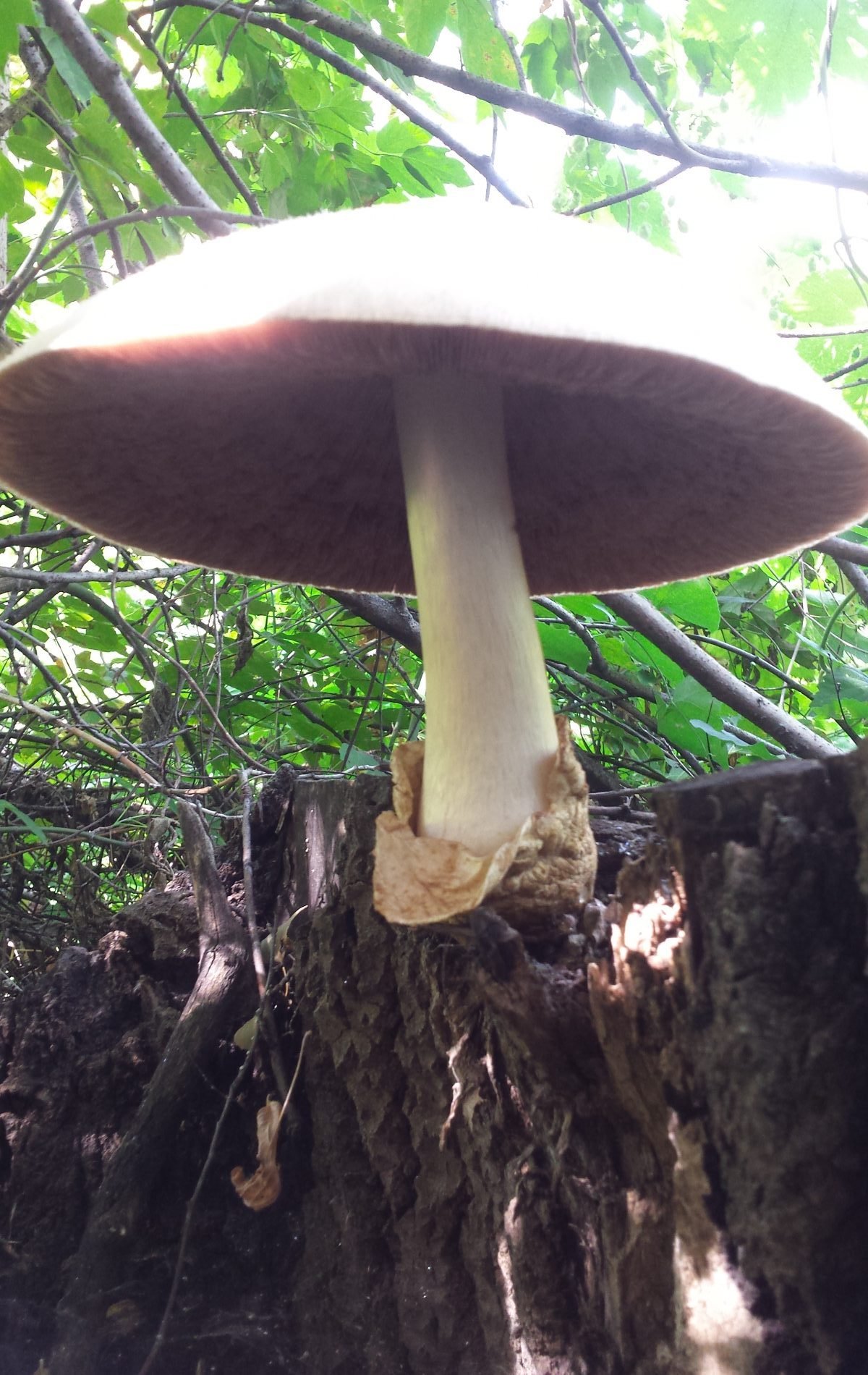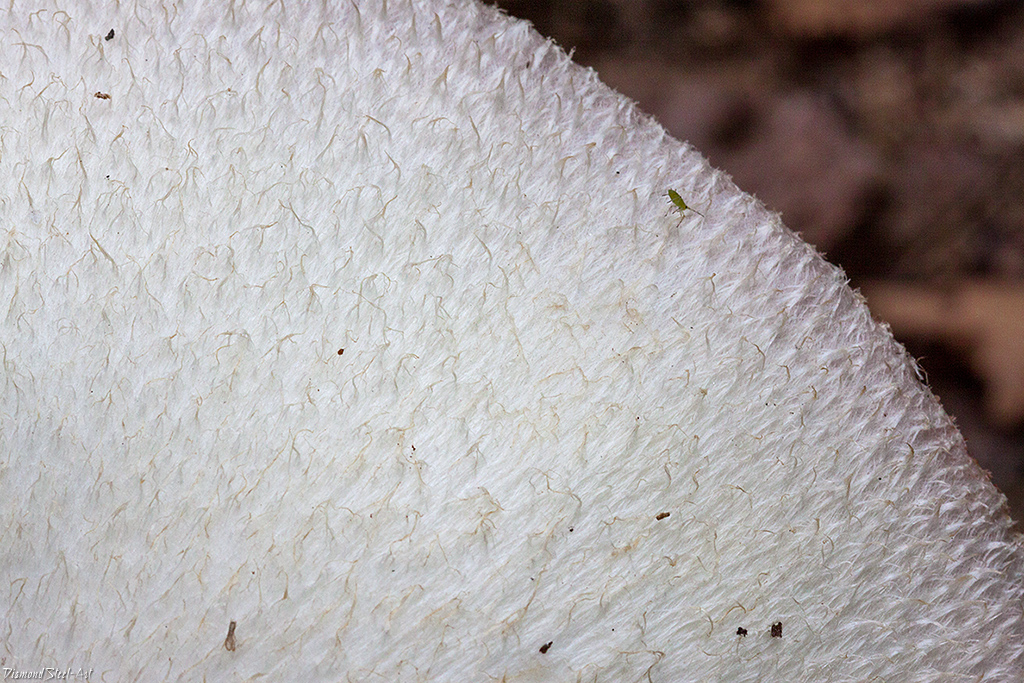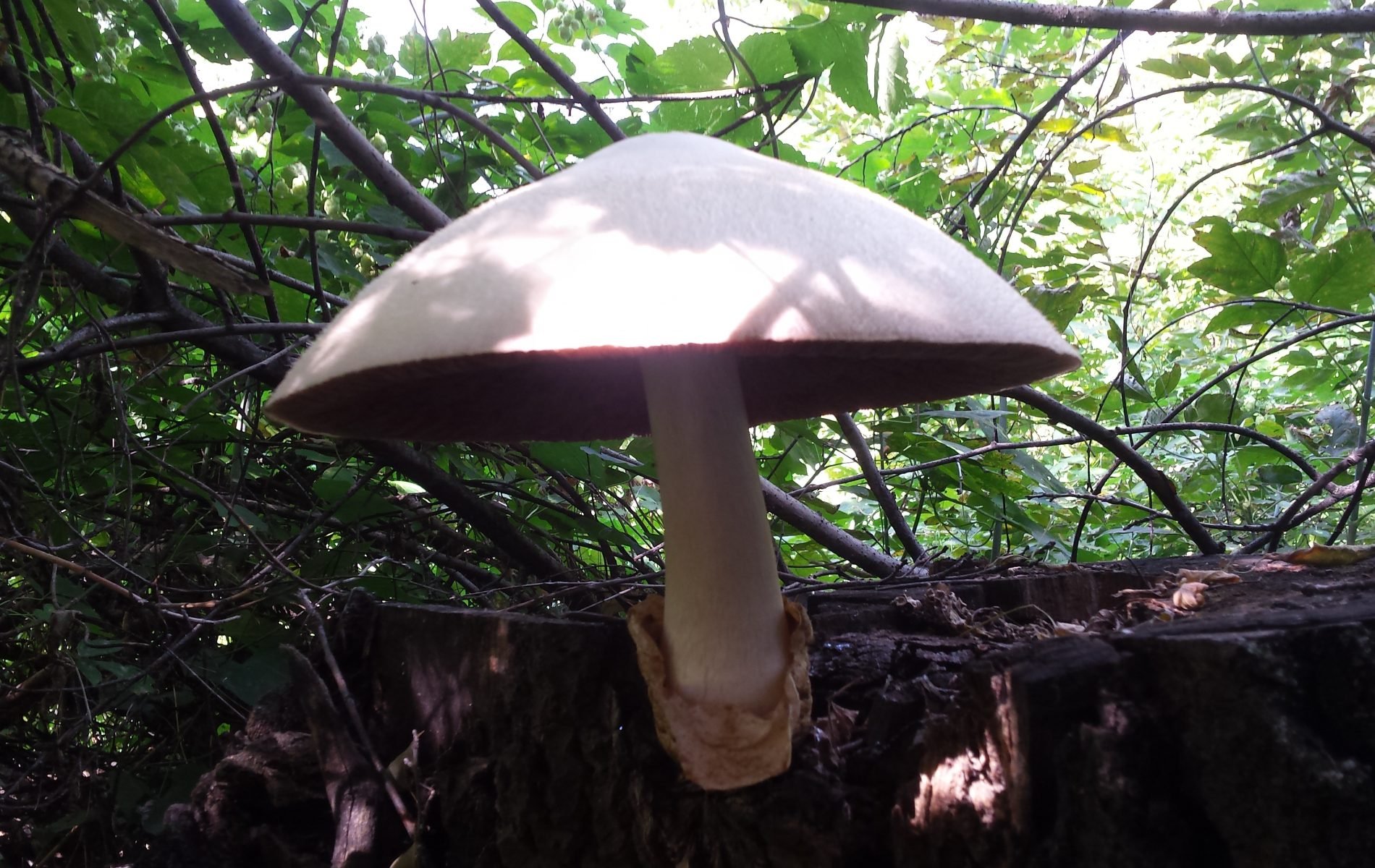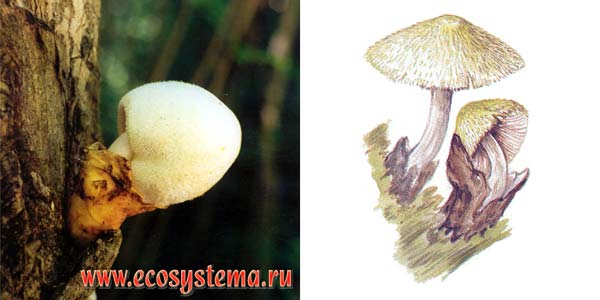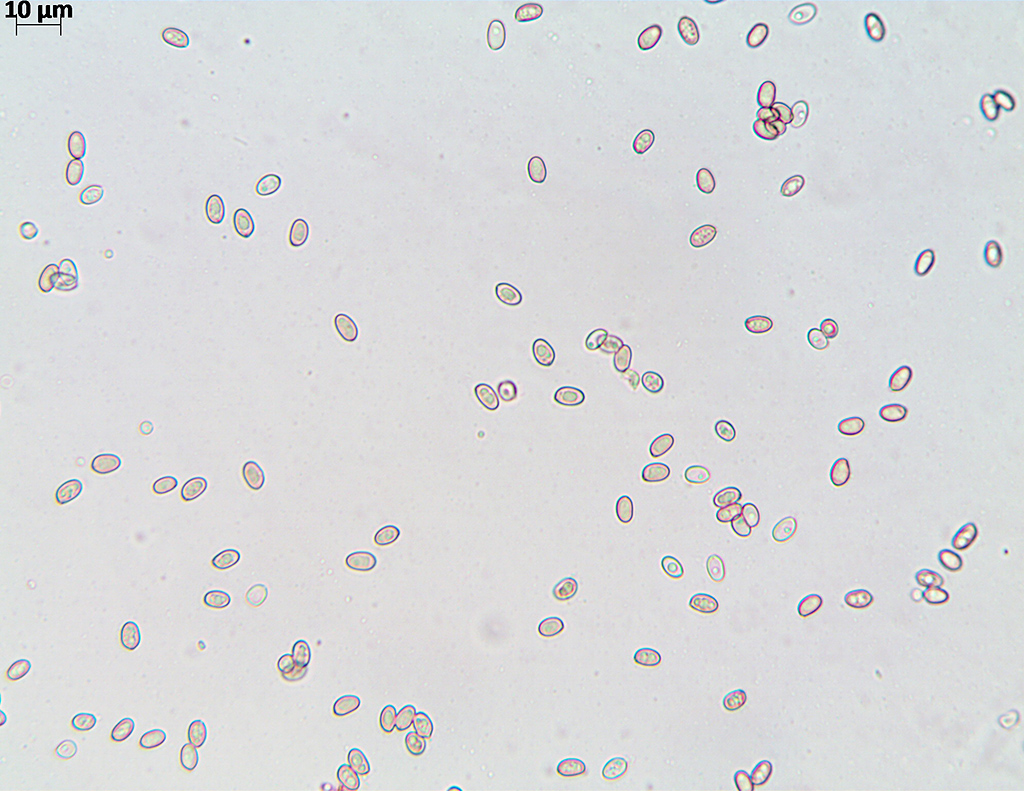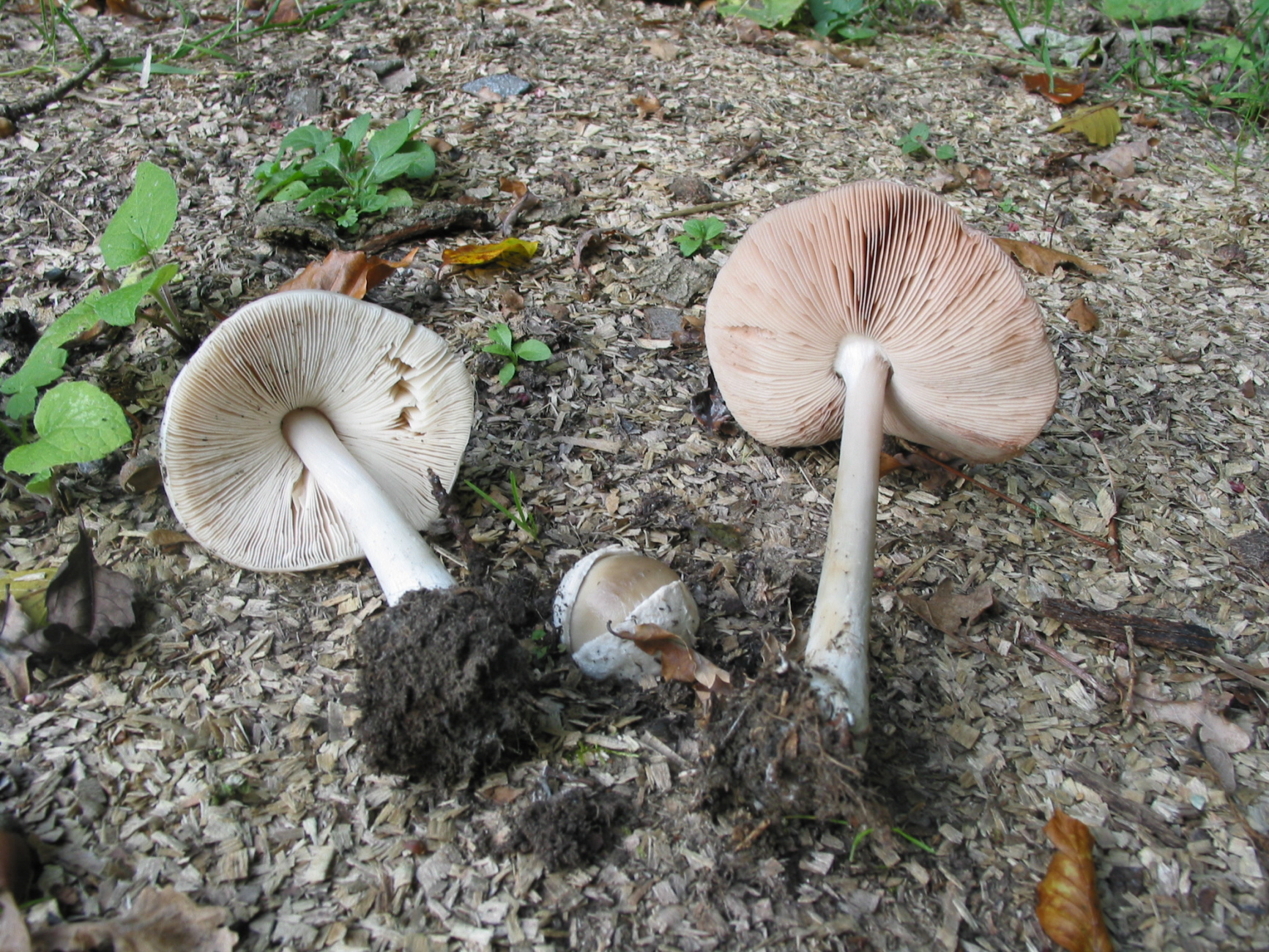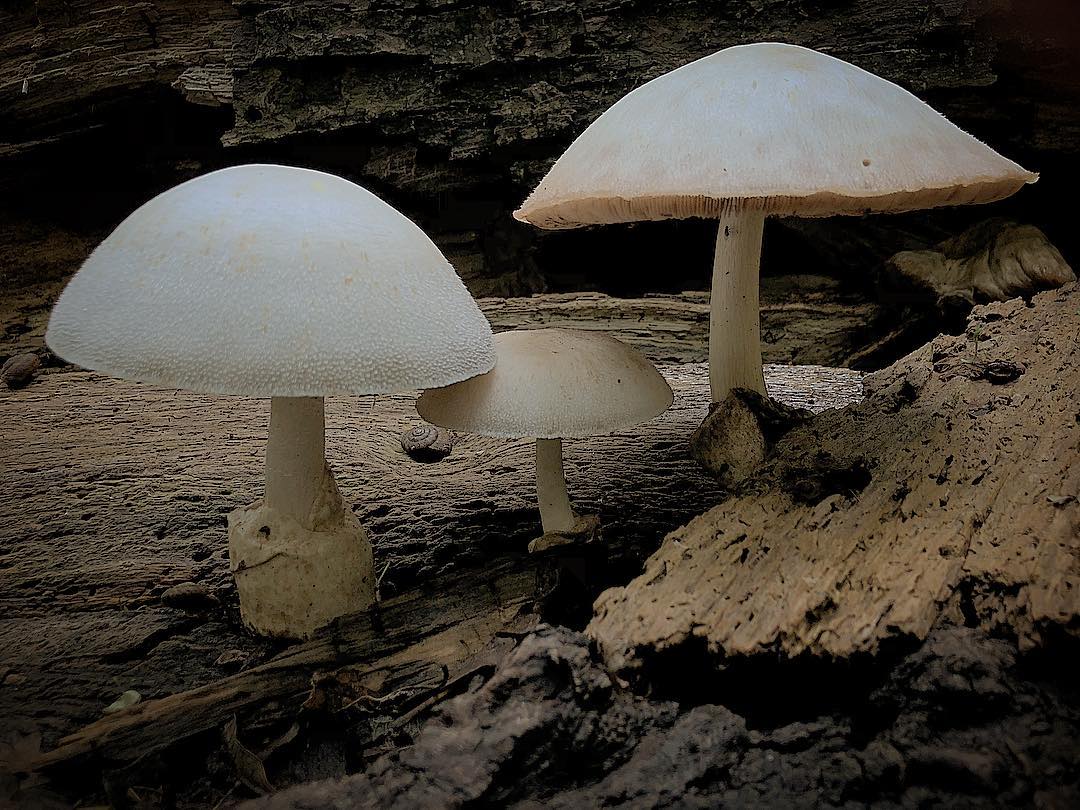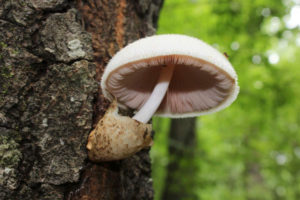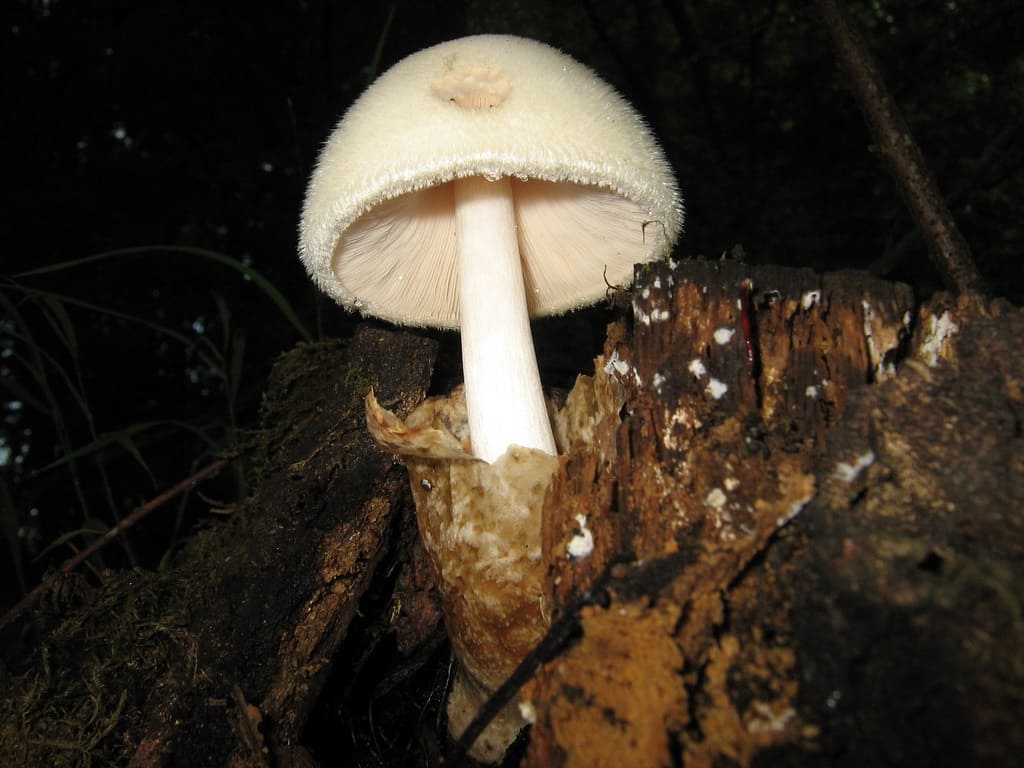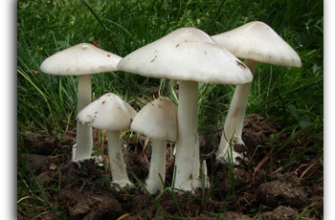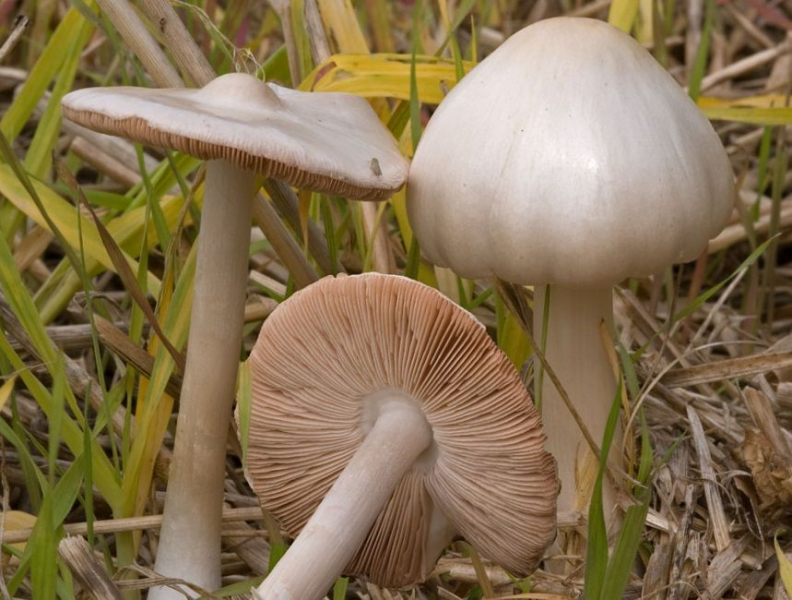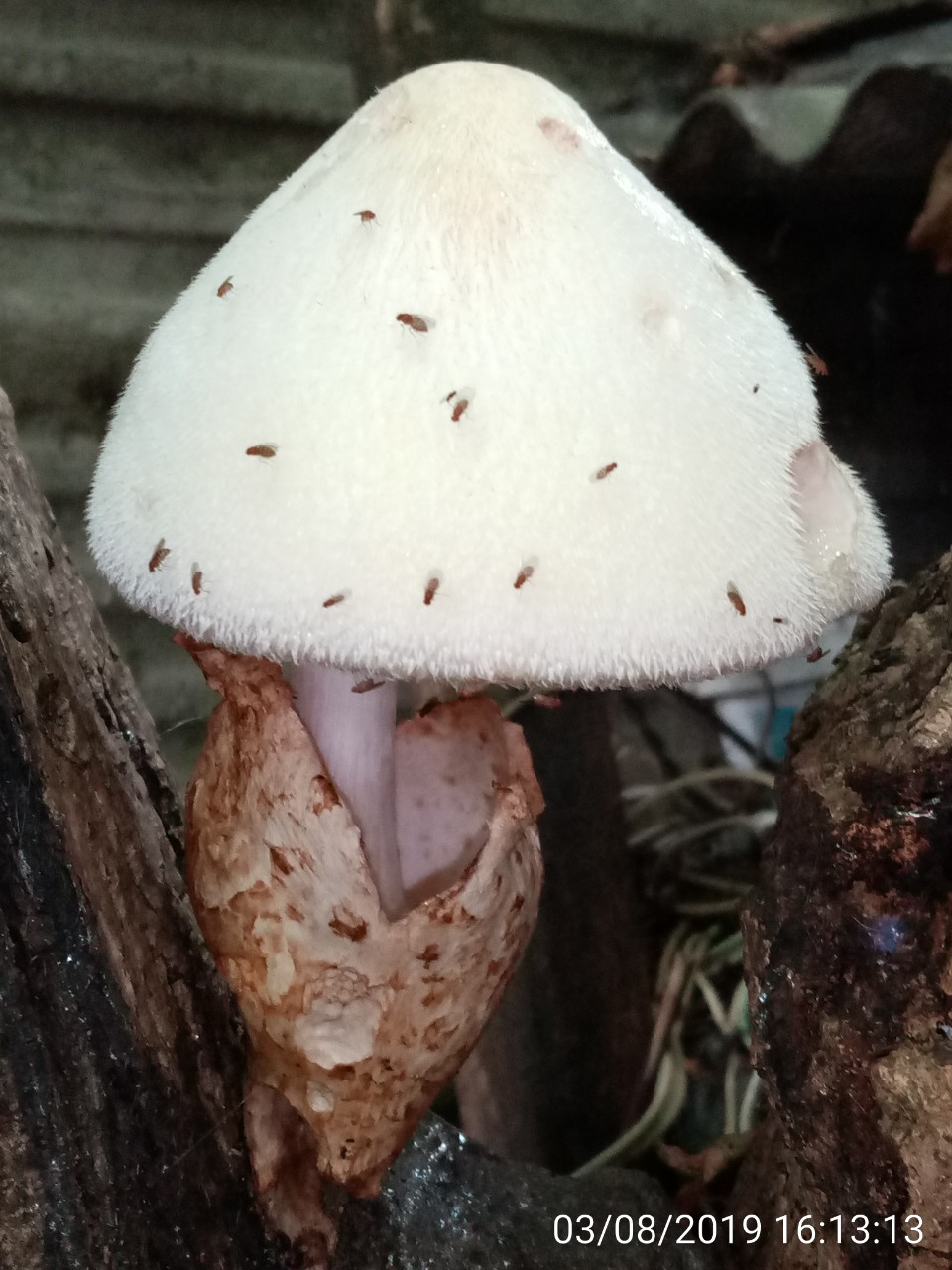Areas of growth of silky volvariella.
This mushroom is quite rare for mushroom pickers. Volvariella silky grows in mixed forests, as well as large natural parks. These fungi inhabit weakened deciduous trees such as poplars, maples and willows. Volvariella silky actively bears fruit from the beginning of July to the end of August.
In many countries, volvariella silky is considered a fairly rare fungus. It is included in the Red Data Books of several countries and is in the lists of species protected by the state. This species is known to professionals, and inexperienced mushroom pickers know little about it, since it is rarely found. Volvariella never form dense aggregates, they occur singly.
The development process of volvariella silky.
The life of this fungus begins from the "egg" stage. In this state, the silky volvariella is enclosed in a common veil. If you cut a mushroom, you can see a mushroom embryo inside.
Then a mushroom begins to emerge from the egg, and it rolls around in all its glory. At first, his hat is bell-shaped, and later it straightens, while the leg remains wrapped in the remains of the bedspread.
In old age, the silky volvariella becomes less attractive - the caps become bald, flabby and wrinkled, and the dazzling whiteness disappears.
The similarity of volvariella silky with other mushrooms.
Due to its color, the silky volvariella has no resemblance to other species, in addition, it has a fibrous structure. She looks very peculiar.
Evaluation of the taste of volvariella silky.
Mushroom pickers consider volvariella edible. In general, volvariella mushrooms are quite small, our heroine is the largest species. Before cooking, the mushrooms are boiled, and the broth is drained.
Growing volvariella.
Volvariella are edible, but their taste is not exceptional. However, some types of volvariella are even cultivated and artificially harvested delicious mushrooms. The only tasty species is considered to be volvariella, which is grown on wood waste or on rice straw.
Related species.
Volvariella mucous head is a conditionally edible mushroom. The cap varies from ovoid to convex-outstretched with a blunt wide tubercle in the center. Her color is white-gray or gray-brown. In wet weather, its surface is slimy. The mushroom pulp is loose and thin, its smell and taste are not expressed. The leg is long and thin, white or gray-yellow in color.
These volvariella settle not on trees, but on soil, and on humus, for example, it can be found on compost heaps, on stubble, in beds, and the like, and this species is rarely found in the forest. Fruiting of the mucoushead volvariella occurs from July to September. Fruit bodies appear singly or in small groups.
The parasitic volvariella is an inedible relative of the silky volvariella. Her hat is thin, at first spherical, and then flat. The skin is dry, covered with fluff. The color of the cap can be off-white or brownish. The leg is strong, with a silky surface. The pulp is spongy, with a sweetish taste and pleasant smell.
Volvariels of this species settle on the remains of other fungi. Sometimes parasitic volvariella are found in numerous colonies. They grow in summer.
| Volvariella mucous head | ||||||||||||||||||||||
| Volvariella mucous head (Volvariella gloiocephala) | ||||||||||||||||||||||
| Scientific classification | ||||||||||||||||||||||
|---|---|---|---|---|---|---|---|---|---|---|---|---|---|---|---|---|---|---|---|---|---|---|
intermediate ranks
|
||||||||||||||||||||||
| International scientific name | ||||||||||||||||||||||
|
Volvariella gloiocephala(DC.) Boekhout & Enderle, 1986 |
||||||||||||||||||||||
| Synonyms | ||||||||||||||||||||||
|
Volvariella mucous head (lat.Volvariella gloiocephala) - a mushroom of the genus Volvariella of the family Pluteaceae (Pluteaceae).
Synonyms:
- Russians: volvariella slimy, volvariella fine, volvariella viscous hat
- Latin:
- Volvariella gloiocephala (DC.) Boekh. & Enderle, 1986basionym
- Volvaria speciosa (Fr.) Gillet 1876
- Volvariopsis gloiocephala (DC.) Murrill, 1917
- Agaricus gloiocephalus (DC., 1815
- Agaricus emendatior (Berk. & M.A. Curtis, 1859
- Agaricus pubescens Schumach., 1815
- Amanita speciosaFr., 1951
- Agaricus speciosus Fr., 1821
- Pluteus speciosus Fr., 1836
Some sources distinguish light-colored forms like Volvariella speciosa (Fr.) Singer, 1951 and darker ones like Volvariella gloiocephala (DC.) Boekh. & Enderle, 1986
Red Book
Are you here:
Home - Red Data Book of the Amur Region - Volvariella rising
Volvariella rising
Volvariella rising - Volvariella surrecta (Knapp) Singer
Family Plute - Pluteaceae
Category and status .. 4. Species with undefined status (there is not enough information about the current status of this taxon).
A brief description of. In Russia, the only known locality of the species from the Amur Region is the Mukhinka forest tract (1). General distribution - Europe: Austria, Great Britain, Sweden, France, Denmark, Italy, Netherlands, Switzerland, Germany, Hungary, Poland, Ukraine; North America: USA, Canada; North Africa.
A brief description of. The cap is 3-8 cm in diameter, thin fleshy, at first bell-shaped, later prostrate, with a tubercle, white or whitish, creamy in the center, slightly brown with age, radially fibrous to the edge, fine tomentose, dry.
The plates are whitish, then pinkish, thin, widened in the middle, frequent. Spores 5-7 x 3-4 microns, pink, ellipsoidal, ovoid, smooth. The leg is 4-9 x 0.4-1.2 cm, central, cylindrical, even, sometimes slightly curved in the center, widening towards the base, white, fine-grained, ovoid, free, with 2-3 lobes, white Volvo.
The pulp is white, does not change during autooxidation, without a special smell, with a pleasant taste (2). It has no nutritional value due to the small size of the fruit chalk.
Features of ecology and phytocoenology. Volvariella ascending settles on the caps of some species of the family Ryadovkovye - Tricholomataceae (species of the genera Clitocybe, Tricholoma, Lepista) in those phytocenoses where there is a suitable substrate.
Limiting factors. Not studied. Possibly, the reason for its rare occurrence is a narrow substrate specialization.
Security measures taken. Protected in the Blagoveshchensk reserve.
Necessary security measures. Search for new locations of the species. Creation of mycological micro-reserves.
Sources of information. 1. Taranina, 2005; 2. Wasser, 1992. Compiled. ON. Kochunov.
|
20.10.2015 20:38:08
Back forward
-
Menu
- home
- Photo gallery
-
Animals
- Mammals
- Birds
- Fishes
- Amphibians
- Reptiles
- Insects
- Crustaceans
- Worms
- Molluscs
-
Plants
- Angiosperms
- Gymnosperms
- Ferns
- Mosses
- Seaweed
- Lichens
- Mushrooms
- Moscow
-
Moscow region
- Mammals
- Birds
- Invertebrates
- Pisces, presm., Terrestrial.
- Plants
- Mushrooms, mosses, lichens
-
Voronezh region
- Plants
- Animals
-
Republic of Crimea
- Plants
- Animals
-
Rostov region
- Plants
- Animals
-
Krasnodar Territory
- Plants
- Animals
-
Leningrad region
- Plants
- Animals
-
Pskov region
- Plants
- Animals
-
Sverdlovsk region
- Plants
- Animals
-
Saratov region
- Mushrooms
- Bryophytes
- Ferns
- Amur region
- Krasnoyarsk Territory
- Belgorod region
-
Chelyabinsk region
- Plants
- Animals
-
IUCN Red List
- Extinct mammals
- Rare birds of the world
- Cetaceans
- Carnivores
- Reserves of Russia
- Wild animals
- Birds of Russia
- Download the Red Book
- Basic documents
- Custom sog.
- .
Possible harm and contraindications
Like all mushrooms, volvariella has some collection features, non-observance of which can harm health.
It is necessary to pick mushrooms in an ecologically clean area. Since mushrooms do not have their own excretory system, they accumulate in themselves everything that the environment contains.Do not pick mushrooms near a busy road, in industrial areas, otherwise you can get poisoning with heavy metals, which usually contaminate the soil in such places.
If you are not sure that this is definitely a volvariella, such a mushroom should never be cut off, it may turn out to be poisonous.
At first, it is better to turn to experienced mushroom pickers. Which will show where and when it is better to collect a specific species, but it is better to take such a person with you, and clearly see everything.
Do not pick too large and old mushrooms, they can be harmful to health. Better to leave them so that they leave their disputes.
Never buy mushrooms off the hands of strangers. Even if it's just volvariella. It is not known where or when it was collected. Even if the mushrooms themselves were collected in a clean place and do not contain harmful impurities, their shelf life is very short, so they may not have any taste due to a long stay in the cut state.
The collected mushrooms must be washed thoroughly. There should be no dirt or dirt left on them.
It should also be remembered that mushrooms, despite all their benefits, are very heavy food for the body, so eating more than 300 grams per week is not recommended.
For the same reason, people with gastrointestinal disorders, children under 6 and older men and women should not eat mushrooms.
Volvariella is beautiful (mucous head)
Category: conditionally edible.
The beautiful volvariella mushroom (mucous head) is the largest representative of its kind.
Cap Volvariella gloiocephala (diameter 6-17 cm): white or grayish, rarely brownish. In young mushrooms, it has the shape of a small chicken egg, in the rest it has a bell with strongly drooping edges and a tubercle in the center. Dry and velvety to the touch, covered with sticky mucus in wet weather.
The leg of the volvariella is beautiful (height 4-22 cm): usually grayish-white or dirty yellow, solid, without a ring.
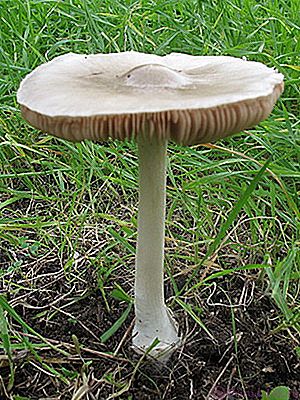
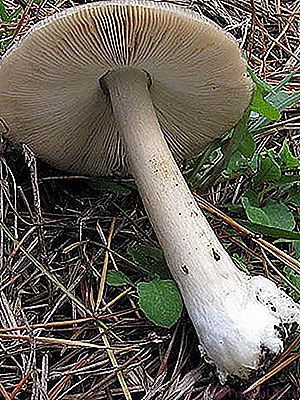
It has the shape of a cylinder, and at the base it is shaped like a tuber. In a young mushroom, felt to the touch, becomes smooth over time.
Plates: pinkish or light brown, frequent and wide, rounded.
Flesh: white and very loose, without a pronounced odor.
Volvariella's counterparts: gray float (Amanita vaginata) and white amanita. The volvariella differs from the gray float in its grayish cap and deep pink plates. And almost all fly agarics have a ring on their legs.
When it grows: from mid-July to almost the end of October in the temperate zone of the Eurasian continent and in the Far East.
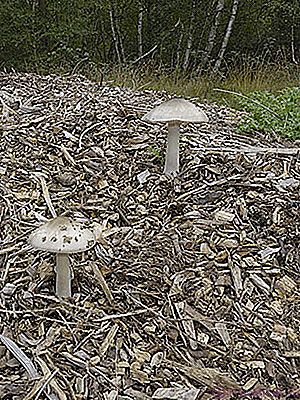
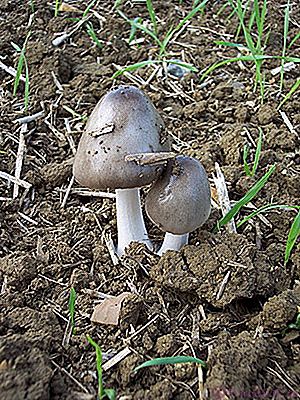
Where can you find it: on garbage and dung heaps, rotten bark or in broken hay.
Eating: after 10-15 minutes of boiling. It is considered a conditionally edible mushroom, of no interest for cooking.
Application in traditional medicine: not applicable.
Other names: mucous volvariella, mucous head volvariella, viscous head volvariella, mucous head volvariella.
Silky volvariella - from birth to sunset
? svetkuban (svetkuban
) wrote, 2014-09-11 15:34:00svetkuban 2014-09-11 15:34:00
Isn't it a hat from Ms. Brylsky from The Irony of Fate?
Once in a nearby forest, a 15-minute walk from my house, I accidentally stumbled upon this amazing mushroom.
I knew about its existence from mushroom reference books, but I never saw it alive. And here, on a huge old completely dry poplar, not just one Volvariella grew, but a whole family of these mushrooms. Someone is at the foot of the tree giant. Others hid in a deep crevice between huge branches.
Still others climbed high up.
The same poplar
These mushrooms appeared on the tree in autumn from September. And, replacing each other, they grew here until November. I managed to trace their development path from birth to death.
A newborn volvariella silky is enclosed in an egg or volva (from which it got its name).
This mushroom got such a strange name due to the fact that the young mushroom is enclosed in a common shell - volva, which determined the generic name of the mushroom. As the fungus grows, the volva breaks apart and forms a saccular formation at the base of the leg.
The cap is up to 20 cm in diameter, white, first bell-shaped, then open, silky. It is one of the most beautiful lamellar mushrooms growing on wood.
Young Volvariella has recently hatched from her Volvo. There is still a Volvo cap on the top of the head.
And the silk on the hat is just perfect.
In Europe, it is found in the south. Loves warmth.
Volvariella silky has a white flesh, which turns yellow as the mushroom ages, the taste and smell are pleasant.
Volvariella silky grows from July to October on dead trunks of maples, elms, poplars, and can grow in open hollows. Not common.
The silk surface of the cap of a young mushroom is very soft - well, just silk.
Young beauty Volvariella in the juice itself. It's time to collect it. At this age, Volvariella is no longer worth collecting - it is old and pretty much eaten by insects. Old Volvariella begins to dry out.
Another day and this old woman Volvariella will completely droop and fall with her hat on the ground. Her days are numbered; sometimes Volvariella climb a tree very high. And they look with a grin at the unlucky mushroom pickers. It is impossible to get them.
THE STORY IS ENDED
Red Book
Are you here:
Home - Red Book of Krasnodar Territory - Plants listed in the Red Book of Krasnodar Territory - Satin Volvariella
Volvariella satin

Volvariella satin - Volvariella bombycina (Schaeff .: Fr. 1821) Singer, 1951
Family Pluteyne - Pluteaceae
Category and status. 3 "Rare" - 3, RD. Circum-Holarctic species, scarce throughout its range.
Category according to the criteria of the IUCN Red List
Regional populations are classified as Near Threatened, NT; A. A. Sopina (Kiyashko).
Not belong.
Brief morphological characteristics
A mushroom with large lamellar fruit bodies that develop on wood. The cap is 7–20 cm in diameter, fleshy, first spherical, then bell-shaped or half-spread with a tubercle, white, then pale yellowish, yellowish-cream to pale lemon-yellow, dry, silky-fibrous to fibrous-scaly, often in the center almost smooth.
The plates are thick, thin, white, then pink. Leg 6–20? 1–2 cm, swollen at the base, smooth, white, with a voluminous loose fibrous-membranous, lobed edge, whitish to cream or yellowish volva. The pulp is white, slightly yellowing, without any special smell or taste. Disputes (7, 5) 8-10? (4.3) 5–6 µm, ellipsoidal, ovoid, smooth, pale pink.
Spreading
Common area: Europe; Caucasus (Georgia, Azerbaijan); Front, Central Asia; Japan; China; North Africa ; North America .
Russia: European part (Moscow, Voronezh, Belgorod, Penza regions); North Caucasus (KK; KBR (environs of Nalchik on Mount Kizilovka, gorge of the Baksan river in the environs of Elbrus settlement); Ural (Perm region); Western Siberia (Krasnoyarsk Territory); Far East (Primorsky Territory).
Krasnodar Territory: Western Caucasus: Adagum-Pshishsky district (environs of the station Smolenskaya, Krepostnaya); Belo-Labinsky district (environs of the settlement of Kamyshanova Polyana).
Features of biology, ecology and phytocenology
Xylotroph, inhabits large trunks and stumps of deciduous trees, mainly from the genera Ulmus, Populus, Fagus. Found in oak and beech forests in June. In other parts of the range, it lives in various deciduous forests, bears fruit from June to October.
Security measures
It is necessary to control the state of the population, identify new and protect known habitats, and preserve mycelial cultures in collections.
Sources of information. 1. Wasser, 1992; 2. Kovalenko, 1980; 3. Shkhagapsoev, Krapivina, 2004; 4. Nakhutsrishvili, 1975; 5.Elchibaev, 1968; 6. Ivanov, 1988; 7. Bedenko, 1979; 8. Perevedentseva, 1999; 9. Shkhagapsoev, Krapivina, 2004. Compiled. A. A. Sopina (Kiyashko); rice. S. A. Litvinskaya.
|
28.10.2015 20:24:43
Back forward
-
Menu
- home
- Photo gallery
-
Animals
- Mammals
- Birds
- Fishes
- Amphibians
- Reptiles
- Insects
- Crustaceans
- Worms
- Molluscs
-
Plants
- Angiosperms
- Gymnosperms
- Ferns
- Mosses
- Seaweed
- Lichens
- Mushrooms
- Moscow
-
Moscow region
- Mammals
- Birds
- Invertebrates
- Pisces, presm., Terrestrial.
- Plants
- Mushrooms, mosses, lichens
-
Voronezh region
- Plants
- Animals
-
Republic of Crimea
- Plants
- Animals
-
Rostov region
- Plants
- Animals
-
Krasnodar Territory
- Plants
- Animals
-
Leningrad region
- Plants
- Animals
-
Pskov region
- Plants
- Animals
-
Sverdlovsk region
- Plants
- Animals
-
Saratov region
- Mushrooms
- Bryophytes
- Ferns
- Amur region
- Krasnoyarsk Territory
- Belgorod region
-
Chelyabinsk region
- Plants
- Animals
-
IUCN Red List
- Extinct mammals
- Rare birds of the world
- Cetaceans
- Carnivores
- Reserves of Russia
- Wild animals
- Birds of Russia
- Download the Red Book
- Basic documents
- Custom sog.
- .
Definitioner
- Basidia (Basidia)
-
Lat. Basidia. A specialized structure of sexual reproduction in fungi, inherent only in Basidiomycetes. Basidia are terminal (end) elements of hyphae of various shapes and sizes, on which spores develop exogenously (outside).
Basidia are diverse in structure and method of attachment to hyphae.
According to the position relative to the axis of the hypha, to which they are attached, three types of basidia are distinguished:
Apical basidia are formed from the terminal cell of the hypha and are located parallel to its axis.
Pleurobasidia are formed from lateral processes and are located perpendicular to the axis of the hypha, which continues to grow and can form new processes with basidia.
Subasidia are formed from a lateral process, turned perpendicular to the axis of the hypha, which, after the formation of one basidium, stops its growth.
Based on morphology:
Holobasidia - unicellular basidia, not divided by septa (see Fig. A, D.).
Phragmobasidia are divided by transverse or vertical septa, usually into four cells (see Fig. B, C).
By type of development:
Heterobasidia consists of two parts - hypobasidia and epibasidia developing from it, with or without partitions (see Fig. C, B) (see Fig. D).
Homobasidia is not divided into hypo- and epibasidia and in all cases is considered holobasidia (Fig. A).
Basidia is the place of karyogamy, meiosis and the formation of basidiospores. Homobasidia, as a rule, is not functionally divided, and meiosis follows karyogamy in it. However, basidia can be divided into probasidia - the site of karyogamy and metabasidia - the site of meiosis. Probasidium is often a dormant spore, for example in rust fungi. In such cases, probazidia grows with metabasidia, in which meiosis occurs and on which basidiospores are formed (see Fig. E).
See Karyogamy, Meiosis, Gifa.
- Pileipellis
-
Lat. Pileipellis, skin - differentiated surface layer of the cap of agaricoid basidiomycetes. The structure of the skin in most cases differs from the inner flesh of the cap and may have a different structure. The structural features of pileipellis are often used as diagnostic features in descriptions of fungi species.
According to their structure, they are divided into four main types: cutis, trichoderma, hymeniderma and epithelium.
See Agaricoid fungi, Basidiomycete, Cutis, Trichoderma, Gimeniderm, Epithelium.
- Ixokutis
-
Cutis, consisting of hyphae immersed in mucus. The surface of the cap is oily, slippery or slimy.
Lat. Ixocutis.
See Cutis, Gifa.
Areas of growth of silky volvariella.
This mushroom is quite rare for mushroom pickers.Volvariella silky grows in mixed forests, as well as large natural parks. These fungi inhabit weakened deciduous trees such as poplars, maples and willows. Volvariella silky actively bears fruit from the beginning of July to the end of August.

In many countries, volvariella silky is considered a fairly rare fungus. It is included in the Red Data Books of several countries and is in the lists of species protected by the state. This species is known to professionals, and inexperienced mushroom pickers know little about it, since it is rarely found. Volvariella never form dense aggregates, they occur singly.
The development process of volvariella silky.
The life of this fungus begins from the "egg" stage. In this state, the silky volvariella is enclosed in a common veil. If you cut a mushroom, you can see a mushroom embryo inside.

Then a mushroom begins to emerge from the egg, and it rolls around in all its glory. At first, his hat is bell-shaped, and later it straightens, while the leg remains wrapped in the remains of the bedspread.
In old age, the silky volvariella becomes less attractive - the caps become bald, flabby and wrinkled, and the dazzling whiteness disappears.
The similarity of volvariella silky with other mushrooms.
Due to its color, the silky volvariella has no resemblance to other species, in addition, it has a fibrous structure. She looks very peculiar.

Evaluation of the taste of volvariella silky.
Mushroom pickers consider volvariella edible. In general, volvariella mushrooms are quite small, our heroine is the largest species. Before cooking, the mushrooms are boiled, and the broth is drained.
Growing volvariella.
Volvariella are edible, but their taste is not exceptional. However, some types of volvariella are even cultivated and artificially harvested delicious mushrooms. The only tasty species is considered to be volvariella, which is grown on wood waste or on rice straw.

Related species.
Volvariella mucous head is a conditionally edible mushroom. The cap varies from ovoid to convex-outstretched with a blunt wide tubercle in the center. Her color is white-gray or gray-brown. In wet weather, its surface is slimy. The mushroom pulp is loose and thin, its smell and taste are not expressed. The leg is long and thin, white or gray-yellow in color.

These volvariella settle not on trees, but on soil, and on humus, for example, it can be found on compost heaps, on stubble, in beds, and the like, and this species is rarely found in the forest. Fruiting of the mucoushead volvariella occurs from July to September. Fruit bodies appear singly or in small groups.

The parasitic volvariella is an inedible relative of the silky volvariella. Her hat is thin, at first spherical, and then flat. The skin is dry, covered with fluff. The color of the cap can be off-white or brownish. The leg is strong, with a silky surface. The pulp is spongy, with a sweetish taste and pleasant smell.

Volvariels of this species settle on the remains of other fungi. Sometimes parasitic volvariella are found in numerous colonies. They grow in summer.
Development features
The beginning of the development of this type of fungi begins with the growth stage of the "egg". In fact, in this form, she is born, enclosed in a common veil. If the mushroom is divided into two parts, then inside you can see a kind of mushroom embryo. After the egg ripens, a mushroom appears from it. Note that at the beginning of growth, the cap of the fruiting body of the volvariella has a bell-shaped shape, after some time it straightens out, nevertheless, the stem of the specimen also remains wrapped in the remnants of the cover.
The old mushroom, in contrast to young specimens, has a less attractive appearance, the surface of the cap becomes wrinkled, and the color of the fungus that is attractive to the eyes also disappears.
Benefits for the body
The mushroom has medicinal properties and is used in alternative medicine. It synthesizes substances with antioxidant effects. Polysaccharides from mycelial culture have anticancer activity and inhibit the growth of sarcoma, B 16 melanoma, Ehrlich's carcinoma.
A combination of medicines and mushrooms gives an effective result. Treatment with the gifts of nature is recommended after chemotherapy sessions. In any case, the therapeutic course should be monitored by the attending doctor.
The benefits of volvariella in the fight against obesity lie in its high nutritional value and low calorie content. In addition, small quantities of mushrooms improve digestion, normalize metabolism and help remove toxins from the body. It is recommended to consume no more than 300 g per week.
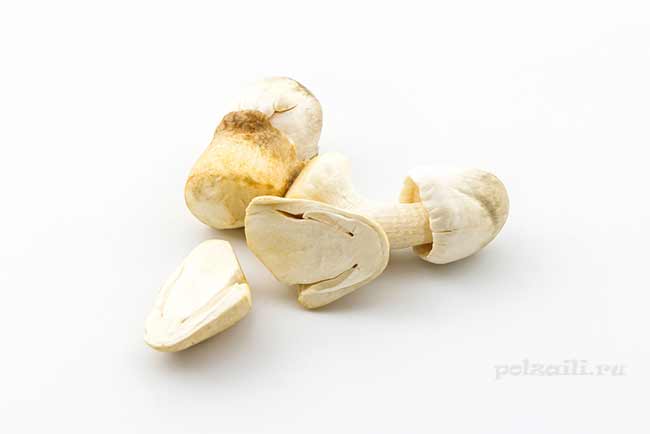
Volvariella silky
Volvariella silky or Volvariella bombycina (Latin Volvariella bombycina) is the most beautiful lamellar fungus growing on wood. The mushroom got its name due to the fact that mushrooms of this genus are covered with a kind of veil - volva. Among mushroom pickers, it is considered an edible mushroom, which is quite rare.
The mushroom is decorated with a bell-shaped scaly cap, reaching a diameter of eighteen centimeters. The plate of the mushroom becomes pinkish brown over time. The long stem of the mushroom at the base is significantly enlarged. Elliptical spores are pink in color. The lamellar layer of the fungus in the process of growth changes color from white to pinkish.
Silky volvariella is rare for mushroom pickers. It is common in mixed forests and large natural parks. A favorite place for settlement chooses dead and weakened by diseases trunks of deciduous trees. Of the trees, preference is given to maple, willow and poplar. The period of active fruiting lasts from early July to late August.
Due to the color and fibrous structure of the cap, this mushroom is very difficult to confuse with other mushrooms. He has a very peculiar look.
Volvariela is suitable for fresh consumption after boiling. The broth is drained after cooking.
In many countries, this rather rare species of fungus is included in the Red Data Books and in the lists of fungi protected from complete destruction.
The mushroom is known to professional mushroom pickers, but little known to inexperienced mushroom pickers and ordinary mushroom pickers, as it comes across quite rarely.
Some types of volvariela can be cultivated artificially, allowing you to get a good harvest of this type of delicious mushroom.
Volvariella gray
Volvariella gray (volvariella viscous hat), Volvariella gloiocephala = Volvaria gloiocephala is a mushroom used for food, but of little value. Caps are collected only from young and immature forms.
1. The cap at an early age is conical or bell-shaped, with age it is flat, finally slightly depressed in the middle, with a wide, weakly pronounced tubercle and an even edge, up to 8 cm in diameter, often radially fibrous, with a smooth, slightly sticky, mucous surface, off-white, grayish-white, grayish-brownish.
2. The pulp in the cap is thin, soft, white, without any special smell or taste.
3. Plates are frequent, with serrated edges, connected by transverse bridges, not adherent to the pedicle; long interspersed with short; young white, then slightly pink, mature pinkish-brownish; spores are elliptical, pinkish, brownish-pinkish, their powder is pinkish-brown.
4. The leg is cylindrical, straight; with a slight thickening at the base, enclosed in a wide off-white volva; up to 16-18 cm in height, up to 1-1.2 cm in thickness; in longitudinal section it is solid or fibrous, the surface in juveniles is white or grayish-white, then grayish-brownish or yellowish-brownish, slightly pubescent.
Where to look
Most often in coniferous forests, orchards, in cultivated fields, vegetable gardens, garbage dumps and heaps of garbage, in old rotting haystacks and straw remnants, on grassy fields, in summer and autumn.
Volvariella is a mushroom with pink plates, pink spores and light, almost white caps. As the name implies, there is a volva at the base of the stem of these mushrooms - the same cup as, for example, fly agarics.

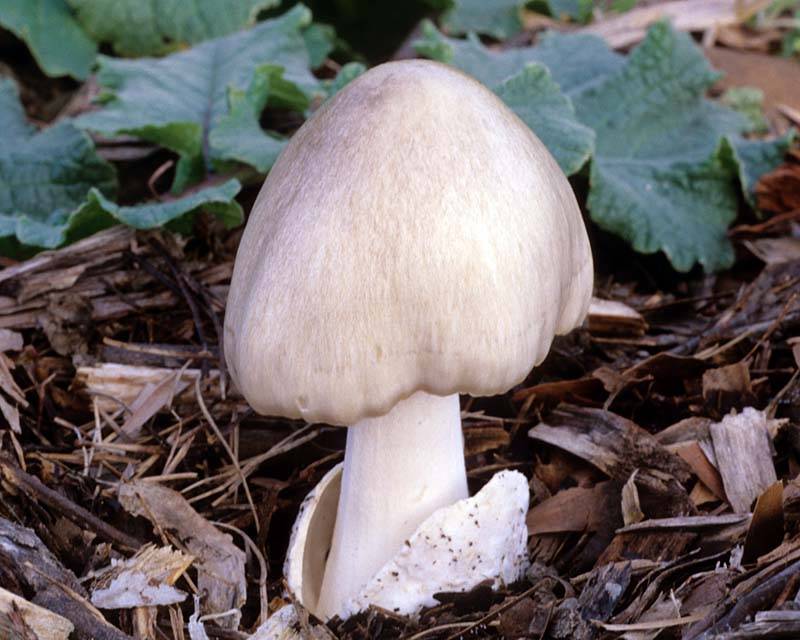
Volvariella is little known to our mushroom pickers. Although in the countries of Southeast Asia, some species of volvariels have long been grown. The substrate is rice straw, which is abundant in these countries. Hence another name for volvariella - "straw mushroom" or "rice mushroom". For the first time, volvariella began to be cultivated in the 18th century in China. The emperor himself was able to appreciate this delicacy, and at the end of the 19th century, volvariella was supplied to the imperial house as a tribute. Volvariella are considered the most delicious mushrooms there.
The peculiarity of volvariella is that the mushroom is very fond of heat and high humidity. That is why the tropics of Southeast Asia are so attractive for these mushrooms.
Volvariella beautiful (Volvariella speciosa)
Valvariella is a saprophyte.
Outwardly, volvariella resemble floats, but their main difference is pink plates and spores. Volvariella can also be confused with the deadly poisonous pale toadstool! True, the difference between them is that the volvariella does not have a ring on the leg, and toadstools do not grow on compost heaps.
Spreading
As mentioned above, volvariella bombicin is a rather rare type of mushroom, so mushroom pickers do not collect it very often. The main habitat of this species is mixed forests, as well as rather large natural parks and protected areas. Volvariella for its growth often chooses the wood of weakened deciduous trees, for example: willows, poplars, maples. The most active time of fruiting of this species of representatives of the mushroom kingdom is the summer season - from mid-July to the last days of August.
Some varieties of volvariella can be grown artificially, which allows the cultivator of this species to collect a fairly solid harvest of these tasty and rare mushrooms.

